Organic Matter Decomposition and Ecosystem Metabolism as Tools to Assess the Functional Integrity of Streams and Rivers–A Systematic Review
Abstract
1. Stream Ecological Integrity and Functional Indicators
2. Organic Matter Decomposition
2.1. Phases and Key Players
2.2. Major Moderators and Sensitivity to Environmental Change
2.3. Practicability of Organic Matter Decomposition as a Bioassessment Tool: Methods, Strengths, and Limitations
3. Ecosystem Metabolism
3.1. Major Moderators and Sensitivity to Environmental Change
3.2. Practicability of Ecosystem Metabolism as a Bioassessment Tool: Methods, Strengths, and Limitations
4. Systematic Map: Organic Matter Decomposition and Ecosystem Metabolism as Bioassessment Tools of Stream Functional Integrity
5. Incorporation of Functional Indicators into Official Bioassessment Programs
Supplementary Materials
Author Contributions
Funding
Conflicts of Interest
References
- Gessner, M.O.; Chauvet, E. A case for using litter breakdown to assess functional stream integrity. Ecol. Appl. 2002, 12, 498–510. [Google Scholar] [CrossRef]
- European Commission. Directive 2000/60/EC of the European Parliament and of the Council of 23 October 2000 establishing a framework for Community action in the field of water policy. Off. J. European Comm. 2000, L327, 1–72. [Google Scholar]
- Barbour, M.T.; Gerritsen, J.; Snyder, B.D.; Stribling, J.B. Rapid Bioassessment Protocols for Use in Streams and Wadeable Rivers: Periphyton, Benthic Macroinvertebrates and Fish, 2nd ed.; EPA 841-B-99-002; U.S. Environmental Protection Agency, Office of Water: Washington, DC, USA, 1999; p. 337. [Google Scholar]
- Sandin, L.; Solimini, A.G. Freshwater ecosystem structure-function relationships: From theory to application. Freshwat. Biol. 2009, 54, 2017–2024. [Google Scholar] [CrossRef]
- Feckler, A.; Bundschuh, M. Decoupled structure and function of leaf-associated microorganisms under anthropogenic pressure: Potential hurdles for environmental monitoring. Freshw. Sci. 2020, 39. [Google Scholar] [CrossRef]
- Verdonschot, P.F.M.; Lee, G.H. Perspectives on the functional assessment of multi-stressed stream ecosystems. Freshwat. Sci. 2020, 39. [Google Scholar] [CrossRef]
- McKie, B.G.; Malmqvist, B. Assessing ecosystem functioning in streams affected by forest management: Increased leaf decomposition occurs without changes to the composition of benthic assemblages. Freshwat. Biol. 2009, 54, 2086–2100. [Google Scholar] [CrossRef]
- Riipinen, M.P.; Davy-Bowker, J.; Dobson, M. Comparison of structural and functional stream assessment methods to detect changes in riparian vegetation and water pH. Freshwat. Biol. 2009, 54, 2127–2138. [Google Scholar] [CrossRef]
- Capon, S.J.; Chambers, L.E.; Mac Nally, R.; Naiman, R.J.; Davies, P.; Marshall, N.; Pittock, J.; Reid, M.; Capon, T.; Douglas, M.; et al. Riparian ecosystems in the 21st century: Hotspots for climate change adaptation? Ecosystems 2013, 16, 359–381. [Google Scholar] [CrossRef]
- Jackson, M.C.; Weyl, O.L.F.; Altermatt, F.; Durance, I.; Friberg, N.; Dumbrell, A.J. Recommendations for the next generation of global freshwater biological monitoring tools. Adv. Ecol. Res. 2016, 55, 615–636. [Google Scholar] [CrossRef]
- New Zealand Ministry for the Environment. National Policy Statement for Freshwater Management 2020; New Zealand Government: Wellington, New Zealand, August 2020; p. 70.
- von Schiller, D.; Acuña, V.; Aristi, I.; Arroita, M.; Basaguren, A.; Bellin, A.; Boyero, L.; Butturini, A.; Ginebreda, A.; Kalogianni, E.; et al. River ecosystem processes: A synthesis of approaches, criteria of use and sensitivity to environmental stressors. Sci. Total Environ. 2017, 596, 465–480. [Google Scholar] [CrossRef]
- Young, R.G.; Matthaei, C.D.; Townsend, C.R. Organic matter breakdown and ecosystem metabolism: Functional indicators for assessing river ecosystem health. J. N. Am. Benthol. Soc. 2008, 27, 605–625. [Google Scholar] [CrossRef]
- Bonada, N.; Prat, N.; Resh, V.H.; Statzner, B. Developments in aquatic insect biomonitoring: A comparative analysis of recent approaches. Ann. Rev. Entomol. 2006, 51, 495–523. [Google Scholar] [CrossRef] [PubMed]
- Cummins, K.W.; Klug, M.J. Feeding ecology of stream invertebrates. Annu. Rev. Ecol. Syst. 1979, 10, 147–172. [Google Scholar] [CrossRef]
- Gessner, M.O. Differences in processing dynamics of fresh and dried leaf litter in a stream ecosystem. Freshwat. Biol. 1991, 26, 387–398. [Google Scholar] [CrossRef]
- Canhoto, C.; Graça, M.A.S. Decomposition of Eucalyptus globulus leaves and three native leaf species (Alnus glutinosa, Castanea sativa and Quercus faginea) in a Portuguese low order stream. Hydrobiologia 1996, 333, 79–85. [Google Scholar] [CrossRef]
- France, R.; Culbert, H.; Freeborough, C.; Peters, R. Leaching and early mass loss of boreal leaves and wood in oligotrophic water. Hydrobiologia 1997, 345, 209–214. [Google Scholar] [CrossRef]
- Campbell, I.C.; James, K.R.; Hart, B.T.; Devereaux, A. Allochthonous coarse particulate organic material in forest and pasture reaches of two south-eastern Australian streams: II. Litter processing. Freshwat. Biol. 1992, 27, 353–365. [Google Scholar] [CrossRef]
- Taylor, B.R.; Bärlocher, F. Variable effects of air-drying on leaching losses from tree leaf litter. Hydrobiologia 1996, 325, 173–182. [Google Scholar] [CrossRef]
- Quinn, J.M.; Burrell, G.P.; Parkyn, S.M. Influences of leaf toughness and nitrogen content on in-stream processing and nutrient uptake by litter in a Waikato, New Zealand, pasture stream and streamside channels. N. Z. J. Mar. Freshwat. Res. 2000, 34, 253–271. [Google Scholar] [CrossRef]
- Bärlocher, F. Fungal colonization of fresh and dried leaves in the river Teign (Devon, England). Nova Hedwigia 1991, 52, 349–357. [Google Scholar]
- Gessner, M.O.; Dobson, M. Colonization of fresh and dried leaf litter by lotic macroinvertebrates. Internat. Verein. Theor. Angew. Limnol. Verh. 1994, 25, 1544. [Google Scholar] [CrossRef]
- Chergui, H.; Pattee, E. The influence of season on the breakdown of submerged leaves. Arch. Hydrobiol. 1990, 120, 1–12. [Google Scholar]
- Gulis, V.; Rong, S.; Kuehn, K.A. Fungal decomposers in freshwater environments. In The Structure and Function of Aquatic Microbial Communities; Hurst, C.J., Ed.; Springer: Cham, Switzerland, 2019; pp. 121–155. [Google Scholar]
- Baldy, V.; Gessner, M.O.; Chauvet, E. Bacteria, fungi and the breakdown of leaf litter in a large river. Oikos 1995, 74, 93–102. [Google Scholar] [CrossRef]
- Pascoal, C.; Cássio, F. Contribution of fungi and bacteria to leaf litter decomposition in a polluted river. Appl. Environ. Microbiol. 2004, 70, 5266–5273. [Google Scholar] [CrossRef]
- Gessner, M.O.; Chauvet, E. Importance of stream microfungi in controlling breakdown rates of leaf litter. Ecology 1994, 75, 1807–1817. [Google Scholar] [CrossRef]
- Arroita, M.; Aristi, I.; Flores, L.; Larrañaga, A.; Díez, J.; Mora, J.; Romaní, A.M.; Elosegi, A. The use of wooden sticks to assess stream ecosystem functioning: Comparison with leaf breakdown rates. Sci. Total Environ. 2012, 440, 115–122. [Google Scholar] [CrossRef] [PubMed]
- Chauvet, E.; Ferreira, V.; Giller, P.S.; McKie, B.G.; Tiegs, S.D.; Woodward, G.; Elosegi, A.; Dobson, M.; Fleituch, T.; Graça, M.A.S.; et al. Litter decomposition as an indicator of stream ecosystem functioning at local-to-continental scales: Insights from the European RivFunction project. Adv. Ecol. Res. 2016, 55, 99–182. [Google Scholar] [CrossRef]
- Hieber, M.; Gessner, M.O. Contribution of stream detrivores, fungi, and bacteria to leaf breakdown based on biomass estimates. Ecology 2002, 83, 1026–1038. [Google Scholar] [CrossRef]
- Nikolcheva, L.G.; Bärlocher, F. Taxon-specific fungal primers reveal unexpectedly high diversity during leaf decomposition in a stream. Mycol. Prog. 2004, 3, 41–49. [Google Scholar] [CrossRef]
- Sampaio, A.; Cortes, R.; Leão, C. Yeast and macroinvertebrate communities associated with leaf litter decomposition in a second order stream. Internat. Rev. Hydrobiol. 2004, 89, 453–466. [Google Scholar] [CrossRef]
- Sampaio, A.; Sampaio, J.P.; Leão, C. Dynamics of yeast populations recovered from decaying leaves in a nonpolluted stream: A 2-year study on the effects of leaf litter type and decomposition time. FEMS Yeast Res. 2007, 7, 595–603. [Google Scholar] [CrossRef] [PubMed]
- Ribblett, S.G.; Palmer, M.A.; Wayne Coats, D. The importance of bacterivorous protists in the decomposition of stream leaf litter. Freshwat. Biol. 2005, 50, 516–526. [Google Scholar] [CrossRef]
- Bärlocher, F.; Stewart, M.; Ryder, D.S. Processing of Eucalyptus viminalis leaves in Australian streams—importance of aquatic hyphomycetes and zoosporic fungi. Fund. Appl. Limnol./Arch. Hydrobiol. 2012, 179, 305–319. [Google Scholar] [CrossRef]
- Howard-Parker, B.; White, B.; Halvorson, H.M.; Evans-White, M.A. Light and dissolved nutrients mediate recalcitrant organic matter decomposition via microbial priming in experimental streams. Freshwat. Biol. 2020, 65, 1189–1199. [Google Scholar] [CrossRef]
- Elosegi, A.; Nicolás, A.; Richardson, J.S. Priming of leaf litter decomposition by algae seems of minor importance in natural streams during autumn. PLoS ONE 2018, 13, e0200180. [Google Scholar] [CrossRef]
- Halvorson, H.M.; Barry, J.R.; Lodato, M.B.; Findlay, R.H.; Francoeur, S.N.; Kuehn, K.A. Periphytic algae decouple fungal activity from leaf litter decomposition via negative priming. Funct. Ecol. 2019, 33, 188–201. [Google Scholar] [CrossRef]
- Baldy, V.; Gessner, M.O. Towards a budget of leaf litter decomposition in a first-order woodland stream. Compt. Rendus Acad. Sci.—Sci. Vie 1997, 320, 747–758. [Google Scholar] [CrossRef]
- Baldy, V.; Gobert, V.; Guérold, F.; Chauvet, E.; Lambrigot, D.; Charcosset, J.Y. Leaf litter breakdown budgets in streams of various trophic status: Effects of dissolved inorganic nutrients on microorganisms and invertebrates. Freshwat. Biol. 2007, 52, 1322–1335. [Google Scholar] [CrossRef]
- Gulis, V.; Suberkropp, K. Leaf litter decomposition and microbial activity in nutrient-enriched and unaltered reaches of a headwater stream. Freshwat. Biol. 2003, 48, 123–134. [Google Scholar] [CrossRef]
- Graça, M.A.S. The role of invertebrates on leaf litter decomposition in streams–a review. Internat. Rev. Hydrobiol. 2001, 86, 383–393. [Google Scholar] [CrossRef]
- Dangles, O.; Gessner, M.O.; Guérold, F.; Chauvet, E. Impacts of stream acidification on litter breakdown: Implications for assessing ecosystem functioning. J. Appl. Ecol. 2004, 41, 365–378. [Google Scholar] [CrossRef]
- Hagen, E.M.; Webster, J.R.; Benfield, E.F. Are leaf breakdown rates a useful measure of stream integrity along an agricultural landuse gradient? J. N. Am. Benthol. Soc. 2006, 25, 330–343. [Google Scholar] [CrossRef]
- Piscart, C.; Genoel, R.; Doledec, S.; Chauvet, E.; Marmonier, P. Effects of intense agricultural practices on heterotrophic processes in streams. Environ. Poll. 2009, 157, 1011–1018. [Google Scholar] [CrossRef] [PubMed]
- Azevedo-Pereira, H.V.S.; Graça, M.A.S.; González, J.M. Life history of Lepidostoma hirtum in an Iberian stream and its role in organic matter processing. Hydrobiologia 2006, 559, 183–192. [Google Scholar] [CrossRef]
- Ferreira, V.; Raposeiro, P.M.; Pereira, A.; Cruz, A.M.; Costa, A.C.; Graça, M.A.S.; Gonçalves, V. Leaf litter decomposition in remote oceanic island streams is driven by microbes and depends on litter quality and environmental conditions. Freshwat. Biol. 2016, 61, 783–799. [Google Scholar] [CrossRef]
- Gonçalves, J.F., Jr.; Graça, M.A.S.; Callisto, M. Leaf-litter breakdown in 3 streams in temperate, Mediterranean, and tropical Cerrado climates. J. N. Am. Benthol. Soc. 2006, 25, 344–355. [Google Scholar] [CrossRef]
- Gonçalves, J.F., Jr.; Graça, M.A.S.; Callisto, M. Litter decomposition in a Cerrado savannah stream is retarded by leaf toughness, low dissolved nutrients and a low density of shredders. Freshwat. Biol. 2007, 52, 1440–1451. [Google Scholar] [CrossRef]
- Ferreira, V.; Graça, M.A.S.; de Lima, J.L.M.P.; Gomes, R. Role of physical fragmentation and invertebrate activity in the breakdown rate of leaves. Arch. Hydrobiol. 2006, 165, 493–513. [Google Scholar] [CrossRef]
- Bastias, E.; Bolivar, M.; Ribot, M.; Peipoch, M.; Thomas, S.A.; Sabater, F.; Martí, E. Spatial heterogeneity in water velocity drives leaf litter dynamics in streams. Freshwat. Biol. 2020, 65, 435–445. [Google Scholar] [CrossRef]
- Ostrofsky, M.L. Relationship between chemical characteristics of autumn-shed leaves and aquatic processing rates. J. N. Am. Benthol. Ass. 1997, 16, 750–759. [Google Scholar] [CrossRef]
- Jabiol, J.; Lecerf, A.; Lamothe, S.; Gessner, M.O.; Chauvet, E. Litter quality modulates effects of dissolved nitrogen on leaf decomposition by stream microbial communities. Microb. Ecol. 2019, 77, 959–966. [Google Scholar] [CrossRef] [PubMed]
- LeRoy, C.J.; Whitham, T.G.; Wooley, S.C.; Marks, J.C. Within-species variation in foliar chemistry influences leaf-litter decomposition in a Utah river. J. N. Am. Benthol. Soc. 2007, 26, 426–438. [Google Scholar] [CrossRef]
- Lecerf, A.; Chauvet, E. Intraspecific variability in leaf traits strongly affects alder leaf decomposition in a stream. Basic Appl. Ecol. 2008, 9, 598–605. [Google Scholar] [CrossRef]
- LeRoy, C.J.; Wooley, S.C.; Lindroth, R.L. Genotype and soil nutrient environment influence aspen litter chemistry and in-stream decomposition. Freshwat. Sci. 2012, 31, 1244–1253. [Google Scholar] [CrossRef]
- Graça, M.A.S.; Poquet, J.M. Do climate and soil influence phenotypic variability in leaf litter, microbial decomposition and shredder consumption? Oecologia 2014, 174, 1021–1032. [Google Scholar] [CrossRef]
- Irons, J.G., III; Bryant, J.P.; Oswood, M.W. Effects of moose browsing on decomposition rates of birch leaf litter in a subarctic stream. Can. J. Fish. Aquat. Sci. 1991, 48, 442–444. [Google Scholar] [CrossRef]
- Martinsen, G.D.; Driebe, E.M.; Whitham, T.G. Indirect interactions mediated by changing plant chemistry:beaver browsing benefits beetles. Ecology 1998, 79, 92–200. [Google Scholar] [CrossRef]
- Pazianoto, L.H.R.; Solla, A.; Ferreira, V. Infection of sweet chestnut trees by a pathogenic oomycete influences leaf litter decomposition more than water temperature rise. Fungal Ecol. 2019, 41, 269–278. [Google Scholar] [CrossRef]
- Suomela, J.; Ayres, M.P. Within-tree and among-tree variation in leaf characteristics of mountain birch and its implications for herbivory. Oikos 1994, 70, 212–222. [Google Scholar] [CrossRef]
- Henriksson, J.; Haukioja, E.; Ossipov, V.; Ossipova, S.; Sillanpää, S.; Kapari, L.; Pihlaja, K. Effects of host shading on consumption and growth of the geometrid Epirrita autumnata: Interactive roles of water, primary and secondary compounds. Oikos 2003, 103, 3–16. [Google Scholar] [CrossRef]
- Spänhoff, B.; Augspurger, C.; Küsel, K. Comparing field and laboratory breakdown rates of coarse particulate organic matter: Sediment dynamics mask the impacts of dissolved nutrients on CPOM mass loss in streams. Aquat. Sci. 2007, 69, 495–502. [Google Scholar] [CrossRef]
- Young, R.G.; Collier, K.J. Contrasting responses to catchment modification among a range of functional and structural indicators of river ecosystem health. Freshwat. Biol. 2009, 54, 2155–2170. [Google Scholar] [CrossRef]
- Frainer, A.; Moretti, M.S.; Xu, W.; Gessner, M.O. No evidence for leaf-trait dissimilarity effects on litter decomposition, fungal decomposers, and nutrient dynamics. Ecology 2015, 96, 550–561. [Google Scholar] [CrossRef]
- Zhang, M.; Cheng, X.; Geng, Q.; Shi, Z.; Luo, Y.; Xu, X. Leaf litter traits predominantly control litter decomposition in streams worldwide. Glob. Ecol. Biogeogr. 2019, 28, 1469–1486. [Google Scholar] [CrossRef]
- Graça, M.A.S.; Pozo, J.; Canhoto, C.; Elosegi, A. Effects of Eucalyptus plantations on detritus, decomposers, and detritivores in streams. Sci. World J. 2002, 2, 1173–1185. [Google Scholar] [CrossRef] [PubMed]
- Hladyz, S.; Åbjörnsson, K.; Giller, P.S.; Woodward, G. Impacts of an aggressive riparian invader on community structure and ecosystem functioning in stream food webs. J. Appl. Ecol. 2011, 48, 443–452. [Google Scholar] [CrossRef]
- Kominoski, J.S.; Follstad Shah, J.J.; Canhoto, C.; Fischer, D.G.; Giling, D.P.; González, E.; Griffiths, N.A.; Larrañaga, A.; LeRoy, C.J.; Mineau, M.M.; et al. Forecasting functional implications of global changes in riparian plant communities. Front. Ecol. Environ. 2013, 11, 423–432. [Google Scholar] [CrossRef]
- Ferreira, V.; Castela, J.; Rosa, P.; Tonin, A.M.; Boyero, L.; Graça, M.A.S. Aquatic hyphomycetes, benthic macroinvertebrates and leaf litter decomposition in streams naturally differing in riparian vegetation. Aquat. Ecol. 2016, 50, 711–725. [Google Scholar] [CrossRef]
- Danger, M.; Gessner, M.O.; Bärlocher, F. Ecological stoichiometry of aquatic fungi: Current knowledge and perspectives. Fungal Ecol. 2016, 19, 100–111. [Google Scholar] [CrossRef]
- Grattan, R.M.; Suberkropp, K. Effects of nutrient enrichment on yellow poplar leaf decomposition and fungal activity in streams. J. N. Am. Benthol. Soc. 2001, 20, 33–43. [Google Scholar] [CrossRef]
- Suberkropp, K.; Chauvet, E. Regulation of leaf breakdown by fungi in streams: Influences of water chemistry. Ecology 1995, 76, 1433–1445. [Google Scholar] [CrossRef]
- Rosemond, A.D.; Benstead, J.P.; Bumpers, P.M.; Gulis, V.; Kominoski, J.S.; Manning, D.W.; Suberkropp, K.; Wallace, J.B. Experimental nutrient additions accelerate terrestrial carbon loss from stream ecosystems. Science 2015, 347, 1142–1145. [Google Scholar] [CrossRef] [PubMed]
- Niyogi, D.K.; Simon, K.; Townsend, C.R. Breakdown of tussock grass in streams along a gradient of agricultural development in New Zealand. Freshwat. Biol. 2003, 48, 1698–1708. [Google Scholar] [CrossRef]
- Gulis, V.; Ferreira, V.; Graça, M.A.S. Stimulation of leaf litter decomposition and associated fungi and invertebrates by moderate eutrophication: Implications for stream assessment. Freshwat. Biol. 2006, 51, 1655–1669. [Google Scholar] [CrossRef]
- Ferreira, V.; Castagneyrol, B.; Koricheva, J.; Gulis, V.; Chauvet, E.; Graça, M.A.S. A meta-analysis of the effects of nutrient enrichment on litter decomposition in streams. Biol. Rev. 2015, 90, 669–688. [Google Scholar] [CrossRef] [PubMed]
- Lecerf, A.; Usseglio-Polatera, P.; Charcosset, J.Y.; Lambrigot, D.; Bracht, B.; Chauvet, E. Assessment of functional integrity of eutrophic streams using litter breakdown and benthic macroinvertebrates. Arch. Hydrobiol. 2006, 165, 105–126. [Google Scholar] [CrossRef]
- Woodward, G.; Gessner, M.O.; Giller, P.S.; Gulis, V.; Hladyz, S.; Lecerf, A.; Malmqvist, B.; McKie, B.G.; Tiegs, S.D.; Cariss, H.; et al. Continental-scale effects of nutrient pollution on stream ecosystem functioning. Science 2012, 336, 1438–1440. [Google Scholar] [CrossRef]
- Brown, J.H.; Gillooly, J.F.; Allen, A.P.; Savage, V.M.; West, G.B. Toward a metabolic theory of ecology. Ecology 2004, 85, 1771–1789. [Google Scholar] [CrossRef]
- Englert, D.; Zubrod, J.P.; Schulz, R.; Bundschuh, M. Variability in ecosystem structure and functioning in a low order stream: Implications of land use and season. Sci. Total Environ. 2015, 538, 341–349. [Google Scholar] [CrossRef]
- Fabre, E.; Chauvet, E. Leaf breakdown along an altitudinal stream gradient. Arch. Hydrobiol. 1998, 141, 167–179. [Google Scholar] [CrossRef]
- Taylor, B.R.; Chauvet, E.E. Relative influence of shredders and fungi on leaf litter decomposition along a river altitudinal gradient. Hydrobiologia 2014, 721, 239–250. [Google Scholar] [CrossRef]
- Boyero, L.; Pearson, R.G.; Gessner, M.O.; Barmuta, L.A.; Ferreira, V.; Graça, M.A.S.; Dudgeon, D.; Boulton, A.J.; Callisto, M.; Chauvet, E.; et al. A global experiment suggests climate warming will not accelerate litter decomposition in streams but might reduce carbon sequestration. Ecol. Lett. 2011, 14, 289–294. [Google Scholar] [CrossRef] [PubMed]
- Tiegs, S.D.; Costello, D.M.; Isken, M.W.; Woodward, G.; McIntyre, P.B.; Gessner, M.O.; Chauvet, E.; Griffiths, N.A.; Flecker, A.S.; Acuña, V.; et al. Global patterns and drivers of ecosystem functioning in rivers and riparian zones. Sci. Adv. 2019, 5, eaav0486. [Google Scholar] [CrossRef] [PubMed]
- Jinggut, T.; Yule, C.M. Leaf-litter breakdown in streams of East Malaysia (Borneo) along an altitudinal gradient: Initial nitrogen content of litter limits shredder feeding. Freshwat. Sci. 2015, 34, 691–701. [Google Scholar] [CrossRef]
- Ferreira, V.; Canhoto, C. Future increase in temperature might stimulate litter decomposition in temperate cold water streams – evidence from a stream manipulation experiment. Freshwat. Biol. 2015, 60, 881–892. [Google Scholar] [CrossRef]
- Gonçalves, A.L.; Graça, M.A.S.; Canhoto, C. The effect of temperature on leaf decomposition and diversity of associated aquatic hyphomycetes depends on the substrate. Fungal Ecol. 2013, 6, 546–553. [Google Scholar] [CrossRef]
- Ferreira, V.; Chauvet, E.; Canhoto, C. Effects of experimental warming, litter species, and presence of macroinvertebrates on litter decomposition and associated decomposers in a temperate mountain stream. Can. J. Fish. Aquat. Sci. 2015, 72, 206–216. [Google Scholar] [CrossRef]
- Medeiros, A.O.; Pascoal, C.; Graça., M.A.S. Diversity and activity of aquatic fungi under low oxygen conditions. Freshwat. Biol. 2009, 54, 142–149. [Google Scholar] [CrossRef]
- González, J.M.; Graça, M.A.S. Conversion of leaf litter to secondary production by a shredding caddis-fly. Freshwat. Biol. 2003, 48, 1578–1592. [Google Scholar] [CrossRef]
- Wood-Eggenschwiler, S.; Bärlocher, F. Aquatic hyphomycetes in sixteen streams in France, Germany and Switzerland. Trans. Brit. Mycol. Soc. 1983, 81, 371–379. [Google Scholar] [CrossRef]
- Raviraja, N.S.; Sridhar, K.R.; Bärlocher, F. Fungal species richness in Western Ghat streams (southern India): Is it related to pH, temperature or altitude. Fungal Div. 1998, 1, 179–191. [Google Scholar]
- Rajashekhar, M.; Kaveriappa, K.M. Diversity of aquatic hyphomycetes in the aquatic ecosystems of the Western Ghats of India. Hydrobiologia 2003, 501, 167–177. [Google Scholar] [CrossRef]
- Petrin, Z.; Englund, G.; Malmqvist, B. Contrasting effects of anthropogenic and natural acidity in streams: A meta-analysis. Proc. Royal Soc. B Biol. Sci. 2008, 275, 1143–1148. [Google Scholar] [CrossRef] [PubMed]
- Cornut, J.; Clivot, H.; Chauvet, E.; Elger, A.; Pagnout, C.; Guérold, F. Effect of acidification on leaf litter decomposition in benthic and hyporheic zones of woodland streams. Water Res. 2012, 46, 6430–6444. [Google Scholar] [CrossRef] [PubMed]
- Ferreira, V.; Guérold, F. Leaf litter decomposition as a bioassessment tool of acidification effects in streams: Evidence from a field study and meta-analysis. Ecol. Ind. 2017, 79, 382–390. [Google Scholar] [CrossRef]
- Colas, F.; Woodward, G.; Burdon, F.J.; Guérold, F.; Chauvet, E.; Cornut, J.; Cébron, A.; Clivot, H.; Danger, M.; Danner, M.C.; et al. Towards a simple global-standard bioassay for a key ecosystem process: Organic-matter decomposition using cotton strips. Ecol. Ind. 2019, 106, 105–466. [Google Scholar] [CrossRef]
- Cook, A.R.; Hoellein, T.J. Environmental drivers of leaf breakdown in an urban watershed. Freshwat. Sci. 2016, 35, 311–323. [Google Scholar] [CrossRef]
- Ferreira, V.; Graça, M.A.S. Do invertebrate activity and current velocity affect fungal assemblage structure in leaves? Internat. Rev. Hydrobiol. 2006, 91, 1–14. [Google Scholar] [CrossRef]
- Pattee, E.; Maamri, A.; Chergui, H. Leaf litter processing and its agents in a temporary Moroccan river. Int. Ver. Theor. Angew. Limnol. Verh. 2001, 27, 3054–3057. [Google Scholar] [CrossRef]
- Abril, M.; Muñoz, I.; Menéndez, M. Heterogeneity in leaf litter decomposition in a temporary Mediterranean stream during flow fragmentation. Sci. Total Environ. 2016, 553, 330–339. [Google Scholar] [CrossRef]
- Arias-Real, R.; Muñoz, I.; Gutierrez-Cánovas, C.; Granados, V.; Lopez-Laseras, P.; Menéndez, M. Subsurface zones in intermittent streams are hotspots of microbial decomposition during the non-flow period. Sci. Total Environ. 2020, 703, 135485. [Google Scholar] [CrossRef] [PubMed]
- Datry, T.; Corti, R.; Claret, C.; Philippe, M. Flow intermittence controls leaf litter breakdown in a French temporary alluvial river: The “drying memory”. Aquat. Sci. 2011, 73, 471–483. [Google Scholar] [CrossRef]
- Fritz, K.M.; Fulton, S.; Johnson, B.R.; Barton, C.D.; Jack, J.D.; Word, D.A.; Burke, R.A. Structural and functional characteristics of natural and constructed channels draining a reclaimed mountaintop removal and valley fill coal mine. J. N. Am. Benthol. Soc. 2010, 29, 673–689. [Google Scholar] [CrossRef]
- Masese, F.O.; Kitaka, N.; Kipkemboi, J.; Gettel, G.M.; Irvine, K.; McClain, M.E. Litter processing and shredder distribution as indicators of riparian and catchment influences on ecological health of tropical streams. Ecol. Ind. 2014, 46, 23–37. [Google Scholar] [CrossRef]
- Yule, C.M.; Gan, J.Y.; Jinggut, T.; Lee, K.V. Urbanization affects food webs and leaf-litter decomposition in a tropical stream in Malaysia. Freshwat. Sci. 2015, 34, 702–715. [Google Scholar] [CrossRef]
- Tagliaferro, M.; Giorgi, A.; Torremorell, A.; Albariño, R. Urbanisation reduces litter breakdown rates and affects benthic invertebrate structure in Pampean streams. Internat. Rev. Hydrobiol. 2020, 105, 33–43. [Google Scholar] [CrossRef]
- Burdon, F.J.; Bai, Y.; Reyes, M.; Tamminen, M.; Staudacher, P.; Mangold, S.; Singer, H.; Räsänen, K.; Joss, A.; Tiegs, S.D.; et al. Stream microbial communities and ecosystem functioning show complex responses to multiple stressors in wastewater. Glob. Change Biol. 2020, 26, 6363–6382. [Google Scholar] [CrossRef]
- Pascoal, C.; Pinho, M.; Cássio, F.; Gomes, P. Assessing structural and functional ecosystem condition using leaf breakdown: Studies on a polluted river. Freshwat. Biol. 2003, 48, 2033–2044. [Google Scholar] [CrossRef]
- Castela, J.; Ferreira, V.; Graça, M.A.S. Evaluation of stream ecological integrity using litter decomposition and benthic invertebrates. Environ. Poll. 2008, 15, 440–449. [Google Scholar] [CrossRef]
- Sabater, S.; Elosegi, A.; Ludwig, R. Framing biophysical and societal implications of multiple stressor effects on river networks. Sci. Total Environ. 2021, 753, 141973. [Google Scholar] [CrossRef]
- Niyogi, D.K.; Harding, J.S.; Simon, K.S. Organic matter breakdown as a measure of stream health in New Zealand streams affected by acid mine drainage. Ecol. Ind. 2013, 24, 510–517. [Google Scholar] [CrossRef]
- Ferreira, V.; Chauvet, E. Synergistic effects of water temperature and dissolved nutrients on litter decomposition and associated fungi. Glob. Change Biol. 2011, 17, 551–564. [Google Scholar] [CrossRef]
- Fernandes, I.; Seena, S.; Pascoal, C.; Cássio, F. Elevated temperature may intensify the positive effects of nutrients on microbial decomposition in streams. Freshwat. Biol. 2014, 59, 2390–2399. [Google Scholar] [CrossRef]
- Webster, J.R.; Benfield, E.F. Vascular plant breakdown in freshwater ecosystems. Annu. Rev. Ecol. Evol. Syst. 1986, 17, 567–594. [Google Scholar] [CrossRef]
- Yeung, A.C.; Kreutzweiser, D.P.; Richardson, J.S. Stronger effects of litter origin on the processing of conifer than broadleaf leaves: A test of home-field advantage of stream litter breakdown. Freshwat. Biol. 2019, 64, 1755–1768. [Google Scholar] [CrossRef]
- Fugère, V.; Lostchuck, E.; Chapman, L.J. Litter decomposition in Afrotropical streams: Effects of land use, home-field advantage, and terrestrial herbivory. Freshwat. Sci. 2020, 39, 497–507. [Google Scholar] [CrossRef]
- Reich, P.B.; Oleksyn, J. Global patterns of plant leaf N and P in relation to temperature and latitude. Proc. Nat. Acad. Sci. USA 2004, 101, 11001–11006. [Google Scholar] [CrossRef]
- Gong, S.; Guo, R.; Zhang, T.; Guo, J. Warming and nitrogen addition increase litter decomposition in a temperate meadow ecosystem. PLoS ONE 2015, 10, e0116013. [Google Scholar] [CrossRef]
- Pozo, J.; Casas, J.; Menéndez, M.; Mollá, S.; Arostegui, I.; Basaguren, A.; Casado, C.; Desclas, E.; Gracía-Avilés, J.; González, J.M.; et al. Leaf-litter decomposition in headwater streams: A comparison of the process among four climatic regions. J. N. Am. Benthol. Soc. 2011, 30, 935–950. [Google Scholar] [CrossRef]
- Webb, J.R.; Pearce, N.J.; Painter, K.J.; Yates, A.G. Hierarchical variation in cellulose decomposition in least-disturbed reference streams: A multi-season study using the cotton strip assay. Landsc. Ecol. 2019, 34, 2353–2369. [Google Scholar] [CrossRef]
- Ferreira, V.; Canhoto, C. Effect of experimental and seasonal warming on litter decomposition in a temperate stream. Aquat. Sci. 2014, 76, 155–163. [Google Scholar] [CrossRef]
- Langhans, S.D.; Tiegs, S.D.; Gessner, M.O.; Tockner, K. Leaf-decomposition heterogeneity across a riverine floodplain mosaic. Aquat. Sci. 2008, 70, 337–346. [Google Scholar] [CrossRef]
- Martínez, A.; Basaguren, A.; Larrañaga, A.; Molinero, J.; Pérez, J.; Sagarduy, M.; Pozo, J. Differences in water depth determine leaf-litter decomposition in streams: Implications on impact assessment reliability. Knowl. Manag. Aquat. Ecosyst. 2016, 417, 23. [Google Scholar] [CrossRef]
- Sandin, L.; Verdonschot, P.F.M. Stream and river typologies—Major results and conclusions from the STAR project. In The Ecological Status of European Rivers: Evaluation and Intercalibration of Assessment Methods; Furse, M.T., Hering, D., Brabec, K., Buffagni, A., Sandin, L., Verdonschot, P.F.M., Eds.; Springer: Dordrecht, The Netherlands, 2006; pp. 33–37. [Google Scholar]
- Tiegs, S.D.; Akinwole, P.O.; Gessner, M.O. Litter decomposition across multiple spatial scales in stream networks. Oecologia 2009, 161, 343–351. [Google Scholar] [CrossRef] [PubMed]
- Sarkanen, K.V.; Ludwig, C.H. Lignins: Occurrence, Formation, Structure and Reactions; John Wiley and Sons: New York, NY, USA, 1971; Volume 10, pp. 228–230. [Google Scholar]
- Díez, J.; Elosegi, A.; Chauvet, E.; Pozo, J. Breakdown of wood in the Agüera stream. Freshwat. Biol. 2002, 47, 2205–2215. [Google Scholar] [CrossRef]
- Elosegi, A.; Díez, J.; Pozo, J. Contribution of dead wood to the carbon flux in forested streams. Earth Surf. Process. Landf. 2007, 32, 1219–1228. [Google Scholar] [CrossRef]
- Spänhoff, B.; Meyer, E.I. Breakdown rates of wood in streams. J. N. Am. Benthol. Soc. 2004, 23, 189–197. [Google Scholar] [CrossRef]
- Tiegs, S.D.; Clapcott, J.E.; Griffiths, N.A.; Boulton, A.J. A standardized cotton-strip assay for measuring organic-matter decomposition in streams. Ecol. Ind. 2013, 32, 131–139. [Google Scholar] [CrossRef]
- Vizza, C.; Zwart, J.A.; Jones, S.E.; Tiegs, S.D.; Lamberti, G.A. Landscape patterns shape wetland pond ecosystem function from glacial headwaters to ocean. Limnol. Oceanogr. 2017, 62, S207–S221. [Google Scholar] [CrossRef]
- Costello, D.M.; Burton, G.A. Response of stream ecosystem function and structure to sediment metal: Context dependency and variation among endpoints. Elementa 2014, 2, 30. [Google Scholar] [CrossRef]
- Griffiths, N.A.; Tiegs, S.D. Organic-matter decomposition along a temperature gradient in a forested headwater stream. Freshwat. Sci. 2016, 35, 518–533. [Google Scholar] [CrossRef]
- Fell, S.; Carrivick, J.L.; Cauvy-Fraunie, S.C.; Crespo-Pérez, V.; Hood, E.W.; Randall, K.C.; Nicholas, K.J.M.; Dumbrell, A.J.; Tiegs, S.D.; Brown, L.E. Glacier loss accelerates fungal decomposition of river organic matter. Nat. Clim. Chang. (in press).
- Tiegs, S.D.; Langhans, S.D.; Tockner, K.; Gessner, M.O. Cotton strips as a leaf surrogate to measure decomposition in river floodplain habitats. J. N. Am. Benthol. Soc. 2007, 26, 70–77. [Google Scholar] [CrossRef]
- Stevenson, A. (Ed.) Oxford Dictionary of English, 3rd ed.; Oxford University Press: Oxford, UK, 2015. [Google Scholar]
- Baker, M.A.; Dahm, C.N.; Valett, H.M. Anoxia, anaerobic metabolism biogeochemistry of the stream water-ground water interface. In Streams and Ground Waters; Jones, J.B., Mulholland, P.J., Eds.; Academic Press: San Diego, CA, USA, 2000; pp. 259–284. [Google Scholar]
- Crenshaw, C.L.; Valett, H.M.; Webster, J.R. Effects of augmentation of coarse particulate organic matter on metabolism and nutrient retention in hyporheic sediments. Freshwat. Biol. 2002, 47, 1820–1831. [Google Scholar] [CrossRef]
- Stanley, E.H.; Casson, N.J.; Christel, S.T.; Crawford, J.T.; Loken, L.C.; Oliver, S.K. The ecology of methane in streams and rivers: Patterns, controls, and global significance. Ecol. Monogr. 2016, 86, 146–171. [Google Scholar] [CrossRef]
- Tank, J.L.; Rosi-Marshall, E.J.; Griffiths, N.A.; Entrekin, S.A.; Stephen, M.L. A review of allochthonous organic matter dynamics and metabolism in streams. J. N. Am. Benthol. Soci. 2010, 29, 118–146. [Google Scholar] [CrossRef]
- Mulholland, P.J.; Fellows, C.S.; Tank, J.L.; Grimm, N.B.; Webster, J.R.; Hamilton, S.K.; Martí, E.; Ashkenas, L.; Bowden, W.B.; Dodds, W.K.; et al. Inter-biome comparison of factors controlling stream metabolism. Freshwat. Biol. 2001, 46, 1503–1517. [Google Scholar] [CrossRef]
- Appling, A.P.; Read, J.S.; Winslow, L.A.; Arroita, M.; Bernhardt, E.S.; Griffiths, N.A.; Hall, R.O., Jr.; Harvey, J.W.; Heffernan, J.B.; Stanley, E.H.; et al. The metabolic regimes of 356 rivers in the United States. Sci. Data 2018, 5, 180292. [Google Scholar] [CrossRef]
- Bernhardt, E.S.; Heffernan, J.B.; Grimm, N.B.; Stanley, E.H.; Harvey, J.W.; Arroita, M.; Appling, A.P.; Cohen, M.J.; McDowell, W.H.; Hall, R.O., Jr.; et al. The metabolic regimes of flowing waters. Limnol. Oceanogr. 2018, 63, 99–118. [Google Scholar] [CrossRef]
- Vannote, R.L.; Minshall, G.W.; Cummins, K.W.; Sedell, J.R.; Cushing, C.E. The river continuum concept. Can. J. Fish. Aquat. Sci. 1980, 37, 130–137. [Google Scholar] [CrossRef]
- Finlay, J.C. Stream size and human influences on ecosystem production in river networks. Ecosphere 2011, 2, art87. [Google Scholar] [CrossRef]
- Dodds, W.K.; Veach, A.M.; Ruffing, C.M.; Larson, D.M.; Fischer, J.L.; Costigan, K.H. Abiotic controls and temporal variability of river metabolism: Multiyear analyses of Mississippi and Chattahoochee River data. Freshwat. Sci. 2013, 32, 1073–1087. [Google Scholar] [CrossRef]
- Thorp, J.H.; Thoms, M.C.; Delong, M.D. The riverine ecosystem synthesis: Biocomplexity in river networks across space and time. River Res. Appl. 2006, 22, 123–147. [Google Scholar] [CrossRef]
- Wiley, M.J.; Osbourne, L.L.; Larimore, R.W. Longitudinal structure of an agricultural prairie river system and its relationship to current stream ecosystem theory. Can. J. Fish. Aquat. Sci. 1990, 47, 373–384. [Google Scholar] [CrossRef]
- Young, R.G.; Huryn, A.D. Interannual variation in discharge controls ecosystem metabolism along a grassland river continuum. Can. J. Fish. Aquat. Sci. 1996, 53, 2199–2211. [Google Scholar] [CrossRef]
- Acuña, V.; Vilches, C.; Giorgi, A. As productive and slow as a stream can be-the metabolism of a Pampean stream. J. N. Am. Benthol. Soc. 2011, 30, 71–83. [Google Scholar] [CrossRef]
- Pieterse, A.; Roos, J. Diurnal variations in the Vaal, a turbid South African river: Physical, chemical and phytoplankton biomass characteristics. Arch. Hydrobiol. 1992, 18, 21–26. [Google Scholar]
- Fellows, C.S.; Bunn, S.E.; Sheldon, F.; Beard, N.J. Benthic metabolism in two turbid dryland rivers. Freshwat. Biol. 2009, 54, 236–253. [Google Scholar] [CrossRef]
- Stanford, J.A.; Ward, J.V. Revisiting the serial discontinuity concept. Reg. Rivers—Res. Manag. 2001, 17, 303–310. [Google Scholar] [CrossRef]
- Roberts, B.J.; Mulholland, P.J.; Hill, W.R. Multiple scales of temporal variability in ecosystem metabolism rates: Results from 2 years of continuous monitoring in a forested headwater stream. Ecosystems 2007, 10, 588–606. [Google Scholar] [CrossRef]
- Uehlinger, U.; Naegeli, M.W. Ecosystem metabolism, disturbance, and stability in a prealpine gravel bed river. J. N. Am. Benthol. Soc. 1998, 17, 165–178. [Google Scholar] [CrossRef]
- Izagirre, O.; Agirre, U.; Bermejo, M.; Pozo, J.; Elosegi, A. Environmental controls of whole-stream metabolism identified from continuous monitoring of Basque streams. J. N. Am. Benthol. Soc. 2008, 27, 252–268. [Google Scholar] [CrossRef]
- Oconnor, B.L.; Harvey, J.W.; McPhillips, L.E. Thresholds of flow-induced bed disturbances and their effects on stream metabolism in an agricultural river. Water Resources Res. 2012, 48, 1–18. [Google Scholar] [CrossRef]
- Acuña, V.; Giorgi, A.; Munoz, I.; Uehlinger, U.; Sabater, S. Flow extremes and benthic organic matter shape the metabolism of a headwater Mediterranean stream. Freshwat. Biol. 2004, 49, 960–971. [Google Scholar] [CrossRef]
- Lamberti, G.A.; Ashkenas, L.R.; Gregory, S.V.; Steinman, A.D. Effects of Three Herbivores on Periphyton Communities in Laboratory Streams. J. N. Am. Benthol. Soc. 1987, 6, 92–104. [Google Scholar] [CrossRef]
- Aristi, I.; Arroita, M.; Larrañaga, A.; Ponsatí, L.; Sabater, S.; von Schiller, D.; Elosegi, A.; Acuña, V. Flow regulation by dams affects ecosystem metabolism in Mediterranean rivers. Freshwat. Biol. 2014, 59, 1816–1829. [Google Scholar] [CrossRef]
- Jassby, A.D.; Platt, T. Mathematical formulation of the relationship between photosynthesis and light for phytoplankton. Limnol. Oceanogr. 1976, 21, 540–547. [Google Scholar] [CrossRef]
- Savoy, P.; Appling, A.P.; Heffernan, J.B.; Stets, E.G.; Read, J.S.; Harvey, J.W.; Bernhardt, E.S. Metabolic rhythms in flowing waters: An approach for classifying river productivity regimes. Limnol. Oceanogr. 2019, 64, 1835–1851. [Google Scholar] [CrossRef]
- Artigas, J.; García-Berhtou, E.; Bauer, D.E.; Castro, M.I.; Cochero, J.; Colautti, D.C.; Cortelezzi, A.; Donato, J.C.; Elosegi, A.; Feijoó, C. Global pressures, specific responses: Effects of nutrient enrichment in streams from different biomes. Environ. Res. Lett. 2013, 8, 014002. [Google Scholar] [CrossRef]
- Acuña, V.; Wolf, A.; Uehlinger, U.; Tockner, K. Temperature dependence of stream benthic respiration in an Alpine river network under global warming. Freshwat. Biol. 2008, 53, 2076–2088. [Google Scholar] [CrossRef]
- Demars, B.O.L.; Manson, J.R.; Olafsson, J.S.; Gislason, G.M.; Gudmundsdottir, R.; Woodward, G.; Reiss, J.; Pichler, D.E.; Rasmussen, J.J.; Friberg, N. Temperature and the metabolic balance of streams. Freshwat. Biol. 2011, 56, 1106–1121. [Google Scholar] [CrossRef]
- Kominoski, J.S.; Rosemond, A.D.; Benstead, J.P.; Gulis, V.; Manning, D.W.P. Experimental nitrogen and phosphorus additions increase rates of stream ecosystem respiration and carbon loss. Limnol. Oceanogr. 2018, 63, 22–36. [Google Scholar] [CrossRef]
- Hall, R.O., Jr.; Beaulieu, J.J. Estimating autotrophic respiration in streams using daily metabolism data. Freshwat. Sci. 2013, 32, 507–516. [Google Scholar] [CrossRef]
- Perkins, D.M.; Yvon-Durocher, G.; Demars, B.O.L.; Reiss, J.; Pichler, D.E.; Friberg, N.; Trimmer, M.; Woodward, G. Consistent temperature dependence of respiration across ecosystems contrasting in thermal history. Glob. Change Biol. 2012, 18, 1300–1311. [Google Scholar] [CrossRef]
- Song, C.; Dodds, W.K.; Rüegg, J.; Argerich, A.; Baker, C.L.; Bowden, W.B.; Douglas, M.M.; Farrell, K.J.; Flinn, M.B.; Garcia, E.A.; et al. Continental-scale decrease in net primary productivity in streams due to climate warming. Nat. Geosci. 2018, 11, 415–420. [Google Scholar] [CrossRef]
- Arroita, M.; Elosegi, A.; Hall, R.O., Jr. Twenty years of daily metabolism show riverine recovery following sewage abatement. Limnol. Oceanog. 2019, 64, S77–S92. [Google Scholar] [CrossRef]
- Aristi, I.; von Schiller, D.; Arroita, M.; Barceló, D.; Ponsatí, L.; García-Galán, M.J.; Sabater, S.; Elosegi, A.; Acuña, V. Mixed effects of effluents from a wastewater treatment plant on river ecosystem metabolism: Subsidy or stress? Freshwat. Biol. 2015, 60, 1398–1410. [Google Scholar] [CrossRef]
- Gucker, B.; Pusch, M.T. Regulation of nutrient uptake in eutrophic lowland streams. Limnol. Oceanogr. 2006, 51, 1443–1453. [Google Scholar] [CrossRef]
- McTammany, M.E.; Benfield, E.F.; Webster, J.R. Recovery of stream ecosystem metabolism from historical agriculture. J. N. Am. Benthol. Soc. 2007, 26, 532–545. [Google Scholar] [CrossRef]
- Griffiths, N.A.; Tank, J.L.; Royer, T.V.; Roley, S.S.; Rosi-Marshall, E.J.; Whiles, M.R.; Beaulieu, J.J.; Johnson, L.T. Agricultural land use alters the seasonality and magnitude of stream metabolism. Limnol. Oceanogr. 2013, 58, 1513–1529. [Google Scholar] [CrossRef]
- Roley, S.S.; Tank, J.L.; Stephen, M.L.; Johnson, L.T.; Beaulieu, J.J.; Witter, J.D. Floodplain restoration enhances denitrification and reach-scale nitrogen removal in an agricultural stream. Ecol. Appl. 2012, 22, 281–297. [Google Scholar] [CrossRef] [PubMed]
- Hope, A.J.; McDowell, W.H.; Wollheim, W.M. Ecosystem metabolism and nutrient uptake in an urban, piped headwater stream. Biogeochemistry 2014, 121, 167–187. [Google Scholar] [CrossRef]
- Hall, R.O., Jr.; Yackulic, C.B.; Kennedy, T.A.; Yard, M.D.; Rosi-Marshall, E.J.; Voichick, N.; Behn, K.E. Turbidity, light, temperature, and hydropeaking control primary productivity in the Colorado River, Grand Canyon. Limnol. Oceanogr. 2015, 60, 512–526. [Google Scholar] [CrossRef]
- Bernot, M.J.; Sobota, D.J.; Hall, R.O., Jr.; Mulholland, P.J.; Dodds, W.K.; Webster, J.R.; Tank, J.L.; Ashkennas, L.R.; Cooper, L.W.; Dahm, C.N.; et al. Inter-regional comparison of land-use effects on stream metabolism. Freshwat. Biol. 2010, 55, 1874–1890. [Google Scholar] [CrossRef]
- Acuña, V.; Muñoz, I.; Giorgi, A.; Omella, M.; Sabater, F.; Sabater, S. Drought and postdrought recovery cycles in an intermittent Mediterranean stream: Structural and functional aspects. J. N. Am. Benthol. Soc. 2005, 24, 919–933. [Google Scholar] [CrossRef]
- Gutiérrez-Cánovas, C.; Velasco, J.; Millán, A. Effects of dilution stress on the functioning of a saline Mediterranean stream. Hydrobiologia 2009, 619, 119–132. [Google Scholar] [CrossRef]
- Traister, E.M.; McDowell, W.H.; Kram, P.; Fottova, D.; Kolarikova, K. Persistent effects of acidification on stream ecosystem structure and function. Freshwat. Sci. 2013, 32, 586–596. [Google Scholar] [CrossRef]
- Young, R.G.; Huryn, A.D. Effects of land-use on stream metabolism and organic matter turnover. Ecol. Appl. 1999, 9, 1359–1376. [Google Scholar] [CrossRef]
- Francoeur, S.N.; Biggs, B.J.F. Short-term effects of elevated velocity and sediment abrasion on benthic algal communities. Hydrobiologia 2006, 561, 59–69. [Google Scholar] [CrossRef]
- Matthaei, C.D.; Piggott, J.J.; Townsend, C.R. Multiple stressors in agricultural streams: Interactions among sediment addition, nutrient enrichment and water abstraction. J. Appl. Ecol. 2010, 47, 639–649. [Google Scholar] [CrossRef]
- Perry, W.B.; Stanford, J.A. Algal growth stimulus by phosphorus in Flathead Lake, Montana, sediments (Selenastrum capricornutum). Northwest Sci. 1982, 56, 48–52. [Google Scholar]
- Dent, L.; Vick, D.; Abraham, K.; Schoenholtz, S.; Johnson, S. Summer temperature patterns in headwater streams of the Oregon Coast Range. J. Am. Water Res. Ass. 2008, 44, 803–813. [Google Scholar] [CrossRef]
- Arismendi, I.; Safeeq, M.; Dunham, J.B.; Johnson, S.L. Can air temperature be used to project influences of climate change on stream temperature? Environ. Res. Lett. 2014, 9, 084015. [Google Scholar] [CrossRef]
- Whitton, B.A.; Ellwood, N.T.W.; Kawecka, B. Biology of the freshwater diatom Didymosphenia: A review. Hydrobiologia 2009, 630, 1–37. [Google Scholar] [CrossRef]
- Aristi, I.; Clapcott, J.E.; Acuña, V.; Elosegi, A.; Mills, H.; Wood, S.A.; Young, R.G. Forestry affects the abundance of Phormidium-dominated biofilms and the functioning of a New Zealand river ecosystem. Marine Freshwat. Res. 2017, 68, 1741–1751. [Google Scholar] [CrossRef][Green Version]
- Brack, W.; Altenburger, R.; Schüürmann, G.; Krauss, M.; López Herráez, D.; van Gils, J.; Slobodnik, J.; Munthe, J.; Gawlok, B.M.; van Wezel, A.; et al. The SOLUTIONS project: Challenges and responses for present and future emerging pollutants in land and water resources management. Sci. Total Environ. 2015, 503–504, 22–31. [Google Scholar] [CrossRef]
- Aristi, I.; Casellas, M.; Elosegi, A.; Insa, S.; Petrovic, M.; Sabater, S.; Acuña, V. Nutrients versus emerging contaminants—Or a dynamic match between subsidy and stress effects on stream biofilms. Environ. Poll. 2016, 212, 208–215. [Google Scholar] [CrossRef]
- Sabater, S.; Elosegi, A.; Ludwig, R. Multiple Stressors in River Ecosystems. Status, impacts and Prospects for the Future; Elsevier: Amsterdam, The Netherlands, 2019. [Google Scholar]
- Blaszczak, J.R.; Delesantro, J.M.; Urban, D.L.; Doyle, M.W.; Bernhardt, E.S. Scoured or suffocated: Urban stream ecosystems oscillate between hydrologic and dissolved oxygen extremes. Limnol. Oceanogr. 2019, 64, 877–894. [Google Scholar] [CrossRef]
- Odum, H.T. Primary production in flowing waters. Limnol. Oceanogr. 1956, 1, 102–117. [Google Scholar] [CrossRef]
- Hall, R.O., Jr.; Hotchkiss, E.R. Stream metabolism. In Methods in Stream Ecology; Lamberti, G., Hauer, F.R., Eds.; Academic Press: Cambridge, MA, USA, 2017; Volume 2, pp. 219–233. [Google Scholar]
- Demars, B.O.L.; Thompson, J.; Manson, J.R. Stream metabolism and the open diel oxygen method: Principles, practice, and perspectives. Limnol. Oceanogr. Meth. 2015, 13, 356–374. [Google Scholar] [CrossRef]
- Elosegi, A.; Gessner, M.; Young, R.G. River doctors: Learning from medicine to enhance ecosystem management. Sci. Total Environ. 2017, 595, 294–302. [Google Scholar] [CrossRef] [PubMed]
- Hornberger, G.M.; Kelly, M.G. Atmospheric reaeration in a river using productivity analysis. J. Environ. Engin. Div. 1975, 101, 729–739. [Google Scholar]
- Holtgrieve, G.W.; Schindler, D.E.; Branch, T.A.; A’mar, Z.T. Simultaneous quantification of aquatic ecosystem metabolism and reaeration using a Bayesian statistical model of oxygen dynamics. Limnol. Oceanogr. 2010, 55, 1047–1063. [Google Scholar] [CrossRef]
- Izagirre, O.; Bermejo, M.; Pozo, J.; Elosegi, A. RIVERMET: An excel-based tool to calculate river metabolism from diel oxygen—concentration curves. Environ. Model. Softw. 2007, 22, 24–32. [Google Scholar] [CrossRef]
- Grace, M.R.; Giling, D.P.; Hladyz, S.; Caron, V.; Thompson, R.M.; Mac Nally, R. Fast processing of diel oxygen curves: Estimating stream metabolism with BASE (BAyesian Single-station Estimation). Limnol. Oceanogr. 2015, 13, 103–114. [Google Scholar] [CrossRef]
- Appling, A.P.; Hall, R.O., Jr.; Yackulic, C.B.; Arroita, M. Overcoming equifinality: Leveraging long time series for stream metabolism estimation. J. Geophysical Res. Biogeosci. 2018, 123, 624–645. [Google Scholar] [CrossRef]
- Giling, D.P.; Grace, M.R.; Mac Nally, R.; Thompson, R.M. The influence of native replanting on stream ecosystem metabolism in a degraded landscape: Can a little vegetation go a long way? Freshwat. Biol. 2013, 58, 2601–2613. [Google Scholar] [CrossRef]
- Doehring, K.; Clapcott, J.E.; Young, R.G. Assessing the functional response to streamside fencing of pastoral Waikato streams, New Zealand. Water 2019, 11, 1347. [Google Scholar] [CrossRef]
- Collier, K.J.; Clapcott, J.E.; Duggan, I.D.; Hamilton, D.P.; Hamer, M.; Young, R.G. Spatial variation of structural and functional indicators in a large New Zealand river. River Res. Appl. 2013, 29, 1277–1290. [Google Scholar] [CrossRef]
- Clapcott, J.E.; Young, R.G.; Neale, M.W.; Doehring, K.; Barmuta, L.A. Land use affects temporal variation in stream metabolism. Freshwat. Sci. 2016, 35, 1164–1175. [Google Scholar] [CrossRef][Green Version]
- Bunn, S.E.; Abal, E.G.; Smith, M.J.; Choy, S.C.; Fellows, C.S.; Harch, B.D.; Kennard, M.J.; Sheldon, F. Integration of science and monitoring of river ecosystem health to guide investments in catchment protection and rehabilitation. Freshwat. Biol. 2010, 55, 223–240. [Google Scholar] [CrossRef]
- Fellows, C.S.; Clapcott, J.E.; Udy, J.W.; Bunn, S.E.; Harch, B.D.; Smith, M.J.; Davies, P.M. Benthic metabolism as an indicator of stream ecosystem health. Hydrobiologia 2006, 572, 71–87. [Google Scholar] [CrossRef]
- Haddaway, N.R.; Bernes, C.; Jonsson, B.G.; Hedlund, K. The benefits of systematic mapping to evidence-based environmental management. Ambio 2016, 45, 613–620. [Google Scholar] [CrossRef] [PubMed]
- Young, R.G.; Huryn, A.D.; Townsend, C.R. Effects of agricultural development on processing of tussock leaf litter in high country New Zealand streams. Freshwat. Biol. 1994, 32, 413–427. [Google Scholar] [CrossRef]
- Pascoal, C.; Cássio, F.; Gomes, P. Leaf breakdown rates: A measure of water quality? Internat. Rev. Hydrobiol. 2001, 86, 407–416. [Google Scholar] [CrossRef]
- Houser, J.N.; Mulholland, P.J.; Maloney, K.O. Catchment disturbance and stream metabolism: Patterns in ecosystem respiration and gross primary production along a gradient of upland soil and vegetation disturbance. J. N. Am. Benthol. Soc. 2005, 24, 538–552. [Google Scholar] [CrossRef]
- Johnson, K.S.; Thompson, P.C.; Gromen, L.; Bowman, J. Use of leaf litter breakdown and macroinvertebrates to evaluate gradient of recovery in an acid mine impacted stream remediated with an active alkaline doser. Environ. Monit. Assess. 2014, 186, 4111–4127. [Google Scholar] [CrossRef]
- Frainer, A.; Polvi, L.E.; Jansson, R.; McKie, B.G. Enhanced ecosystem functioning following stream restoration: The roles of habitat heterogeneity and invertebrate species traits. J. Appl. Ecol. 2018, 55, 377–385. [Google Scholar] [CrossRef]
- Dodds, W.K.; Bruckerhoff, L.; Batzer, D.; Schechner, A.; Pennock, C.; Renner, E.; Tromboni, F.; Bigham, K.; Grieger, S. The freshwater biome gradient framework: Predicting macroscale properties based on latitude, altitude, and precipitation. Ecosphere 2019, 10, e02786. [Google Scholar] [CrossRef]
- Seena, S.; Bärlocher, F.; Sobral, O.; Gessner, M.O.; Dudgeon, D.; McKie, B.G.; Cahuvet, E.; Boyero, L.; Ferreira, V.; Frainer, A.; et al. Biodiversity of leaf litter fungi in streams along a latitudinal gradient. Sci. Total Environ. 2019, 661, 306–315. [Google Scholar] [CrossRef]
- Boyero, L.; Pearson, R.G.; Dudgeon, D.; Graça, M.A.S.; Gessner, M.O.; Albariño, R.J.; Ferreira, V.; Yule, C.M.; Boulton, A.J.; Arunachalam, M.; et al. Global distribution of a key trophic guild contrasts with common latitudinal diversity patterns. Ecology 2011, 92, 1839–1848. [Google Scholar] [CrossRef] [PubMed]
- Wallace, J.B.; Eggert, S.L.; Meyer, J.L.; Webster, J.R. Multiple trophic levels of a forest stream linked to terrestrial litter inputs. Science 1997, 277, 102–104. [Google Scholar] [CrossRef]
- Abelho, M. From litterfall to breakdown in streams: A review. Sci. World J. 2001, 1, 656–680. [Google Scholar] [CrossRef] [PubMed]
- Baldy, V.; Chauvet, E.; Charcosset, J.Y.; Gessner, M.O. Microbial dynamics associated with leaves decomposing in the mainstem and floodplain pond of a large river. Aquat. Microb. Ecol. 2002, 28, 25–36. [Google Scholar] [CrossRef]
- Chauvet, E. Leaf litter decomposition in large rivers: The case of the River Garonne. Limnetica 1997, 13, 65–70. [Google Scholar]
- Molinero, J.; Pozo, J. Impact of a eucalyptus (Eucalyptus globulus Labill.) plantation on the nutrient content and dynamics of coarse particulate organic matter (CPOM) in a small stream. Hydrobiologia 2004, 528, 143–165. [Google Scholar] [CrossRef]
- Molinero, J. Seasonality and composition of benthic coarse particulate organic matter in two coastal tropical streams with different land uses. Hydrobiologia 2019, 838, 29–43. [Google Scholar] [CrossRef]
- Latter, P.M.; Walton, D.W.H. The cotton strip assay for cellulose decomposition in soil: History of the assay and development. In Cotton Strip Assay: An Index of Decomposition in Soils; Harrison, A.F., Latter, P.M., Walton, D.W.H., Eds.; Institute of Terrestrial Ecology, Merlewood Research Station, Grange-over-Sands: Cumbria, UK, 1988; pp. 7–10. [Google Scholar]
- Boulton, A.J.; Quinn, J.M. A simple and versatile technique for assessing cellulose decomposition potential in floodplain and riverine sediments. Arch. Hydrobiol. 2000, 150, 133–151. [Google Scholar] [CrossRef]
- Mlambo, M.C.; Paavola, R.; Fritze, H.; Louhi, P.; Muotka, T. Leaf litter decomposition and decomposer communities in streams affected by intensive forest biomass removal. Ecol. Ind. 2019, 101, 364–372. [Google Scholar] [CrossRef]
- Swan, C.M.; Palmer, M.A. Leaf diversity alters litter breakdown in a Piedmont stream. J. N. Am. Benthol. Soc. 2004, 23, 15–28. [Google Scholar] [CrossRef]
- Aristegi, L.; Izagirre, O.; Elosegi, A. Comparison of several methods to calculate reareation in streams and their effects on metabolism estimations. Hydrobiologia 2009, 635, 113–124. [Google Scholar] [CrossRef]
- Stanaway, D.; Haggerty, R.; Benner, S.; Flores, A.; Feris, K. Persistent metal contamination limits lotic ecosystem heterotrophic metabolism after more than 100 years of exposure: A novel application of the resazurin resorufin smart tracer. Environ. Sci. Technol. 2012, 46, 9862–9871. [Google Scholar] [CrossRef]
- Hill, B.H.; Elonen, C.M.; Herlihy, A.T.; Jicha, T.M.; Mitchell, R.M. A synoptic survey of microbial respiration, organic matter decomposition, and carbon efflux in US streams and rivers. Limnol. Oceanogr. 2017, 62, S147–S159. [Google Scholar] [CrossRef]
- Bergfur, J. Seasonal variation in leaf-litter breakdown in nine boreal streams: Implications for assessing functional integrity. Fund. Appl. Limnol./Arch. Hydrobiol. 2007, 169, 319–329. [Google Scholar] [CrossRef]
- Bergfur, J.; Johnson, R.K.; Sandin, L.; Goedkoop, W. Assessing the ecological integrity of boreal streams: A comparison of functional and structural responses. Fund. Appl. Limnol./Arch. Hydrobiol. 2007, 168, 113–125. [Google Scholar] [CrossRef]
- Collier, K.J.; Clapcott, J.E.; Hamer, M.P.; Young, R.G. Extent estimates and land cover relationships for functional indicators in non-wadeable rivers. Ecol. Ind. 2013, 34, 53–59. [Google Scholar] [CrossRef]
- Estevez, E.; Rodríguez-Castillo, T.; Álvarez-Cabria, M.; Peñas, F.J.; González-Ferreras, A.M.; Lezcano, M.; Barquín, J. Analysis of structural and functional indicators for assessing the health state of mountain streams. Ecol. Ind. 2017, 72, 553–564. [Google Scholar] [CrossRef]
- Northington, R.M.; Benfield, E.F.; Schoenholtz, S.H.; Timpano, A.J.; Webster, J.R.; Zipper, C. An assessment of structural attributes and ecosystem function in restored Virginia coalfield streams. Hydrobiologia 2011, 671, 51–63. [Google Scholar] [CrossRef]
- DaSilva, A.; Xu, Y.J.; Ice, G.; Beebe, J.; Stich, R. Effects of timber harvesting with best management practices on ecosystem metabolism of a low gradient stream on the United States Gulf Coastal Plain. Water 2013, 5, 747–766. [Google Scholar] [CrossRef]
- Aldridge, K.T.; Brookes, J.D.; Ganf, G.G. Rehabilitation of stream ecosystem functions through the reintroduction of coarse particulate organic matter. Rest. Ecol. 2009, 17, 97–106. [Google Scholar] [CrossRef]
- Kupilas, B.; Hering, D.; Lorenz, A.W.; Knuth, C.; Gucker, B. Hydromorphological restoration stimulates river ecosystem metabolism. Biogeosciences 2017, 14, 1989–2002. [Google Scholar] [CrossRef]
- Blersch, S.S.; Blersch, D.M.; Atkinson, J.F. Metabolic variance: A metric to detect shifts in stream ecosystem function as a result of stream restoration. J. Am. Water Res. Ass. 2019, 55, 608–621. [Google Scholar] [CrossRef]
- Bunn, S.E.; Davies, P.M. Biological processes in running waters and their implications for the assessment of ecological integrity. In Assessing the Ecological Integrity of Running Waters. Developments in Hydrobiology; Jungwirth, M., Muhar, S., Schmutz, S., Eds.; Springer: Dordrecht, The Netherlands, 2000; Volume 149, pp. 61–70. [Google Scholar] [CrossRef]
- Palmer, M.A.; Febria, C.M. The heartbeat of ecosystems. Science 2012, 336, 1393–1394. [Google Scholar] [CrossRef] [PubMed]
- Young, R.G.; Clapcott, J.E. Temporal Variability in Ecosystem Metabolism of Rivers in the Manawatu-Whanganui Region—Updated; Prepared for Horizons Regional Council; Cawthron Report No. 1791; Cawthron Institute: Nelson, New Zealand, 2010; p. 25. [Google Scholar]
- Doehring, K.; Young, R.G. Seasonal Patterns in Ecosystem Metabolism of Rivers in the Auckland Region 2003–2009; Prepared for Auckland Regional Council; Cawthron Report No. 1795; Cawthron Institute: Nelson, New Zealand, 2010; p. 23. [Google Scholar]
- Young, R.G.; Doehring, K.A.M.; James, T. River Water Quality in Tasman District 2010; Prepared for Tasman District Council; Cawthron Report No. 1893; Cawthron Institute: Nelson, New Zealand, 2010; p. 165. [Google Scholar]
- Clapcott, J.E.; Doehring, K. Temporal Variation in Ecosystem Metabolism in Relation to Water Quality in the Piako River; Prepared for Waikato Regional Council; Cawthron Report No. 2550; Cawthron Institute: Nelson, New Zealand, 2014; p. 32. [Google Scholar]
- Parkyn, S.; Collier, K.; Clapcott, J.; David, B.; Davies-Colley, R.; Matheson, F.; Quinn, J.; Shaw, W.; Storey, R. The Restoration Indicators Toolkit: Indicators for Monitoring the Ecological Success of Stream Restoration; NIWA: Hamilton, NY, USA, 2010. [Google Scholar]
- Young, R.G. A Trial of Wood Decomposition Rates as an Ecological Assessment Tool in Large Rivers; Prepared for West Coast Regional Council; Cawthron Report No. 1339; Cawthron Institute: Nelson, New Zealand, 2007; p. 6. [Google Scholar]
- Collier, K.J. Wood decay rates and macroinvertebrate community structure along contrasting human pressure gradients (Waikato, New Zealand). N. Z. J. Mar. Freshwat. Res. 2014, 48, 97–111. [Google Scholar] [CrossRef]
- Colas, F.; Baudoin, J.M.; Gob, F.; Tamisier, V.; Valette, L.; Kreutzenberger, K.; Lambrigot, D.; Chauvet, E. Scale dependency in the hydromorphological control of a stream ecosystem functioning. Water Res. 2017, 115, 60–73. [Google Scholar] [CrossRef]
- Thompson, M.S.; Bankier, C.; Bell, T.; Dumbrell, A.J.; Gray, C.; Ledger, M.E.; Lehmann, K.; McKew, B.A.; Sayer, C.D.; Shelley, F.; et al. Gene-to-ecosystem impacts of a catastrophic pesticide spill: Testing a multilevel bioassessment approach in a river ecosystem. Freshwat. Biol. 2016, 61, 2037–2050. [Google Scholar] [CrossRef]
- Carballeira, C.; Villares, R.; Mata-Rivas, B.; Carballeira, A. The cotton-strip assay as an environmental surveillance tool for ecological integrity assessment of rivers affected by WWTP effluents. Water Res. 2020, 169, 115247. [Google Scholar] [CrossRef]
- Aristi, I.; Díez, J.R.; Larrañaga, A.; Navarro-Ortega, A.; Barceló, D.; Elosegi, A. Assessing the effects of multiple stressors on the functioning of Mediterranean rivers using poplar wood breakdown. Sci. Total Environ. 2012, 440, 272–279. [Google Scholar] [CrossRef]
- Brosed, M.; Lamothe, S.; Chauvet, E. Litter breakdown for ecosystem integrity assessment also applies to streams affected by pesticides. Hydrobiologia 2016, 773, 87–102. [Google Scholar] [CrossRef]
- Jabiol, J.; Colas, F.; Guérold, F. Cotton-strip assays: Let’s move on to eco-friendly biomonitoring! Water Res. 2020, 170, 115295. [Google Scholar] [CrossRef]
- Lecerf, A.; Chauvet, E. Diversity and functions of leaf-decaying fungi in human-altered streams. Freshwat. Biol. 2008, 53, 1658–1672. [Google Scholar] [CrossRef]
- Imberger, S.J.; Thompson, R.M.; Grace, M.R. Searching for effective indicators of ecosystem function in urban streams: Assessing cellulose decomposition potential. Freshwat. Biol. 2010, 55, 2089–2106. [Google Scholar] [CrossRef]
- Noel, L.; Bärlocher, F.; Culp, J.M.; Seena, S. Nutrient enrichment and flow regulation impair structure and function of a large river as revealed by aquatic hyphomycete species richness, biomass, and decomposition rates. Freshwat. Sci. 2016, 35, 1148–1163. [Google Scholar] [CrossRef]
- Hladyz, S.; Tiegs, S.D.; Gessner, M.O.; Giller, P.S.; Risnoveanu, G.; Preda, E.; Nistorescu, M.; Schindler, M.; Woodward, G. Leaf-litter breakdown in pasture and deciduous woodland streams: A comparison among three European regions. Freshwat. Biol. 2010, 55, 1916–1929. [Google Scholar] [CrossRef]
- Fritz, K.M.; Fulton, S.; Johnson, B.R.; Barton, C.D.; Jack, J.D.; Word, D.A.; Burke, R.A. An assessment of cellulose filters as a standardized material for measuring litter breakdown in headwater streams. Ecohydrology 2011, 4, 469–476. [Google Scholar] [CrossRef]
- Krenz, R.J.; Schoenholtz, S.H.; Zipper, C.E. Riparian subsidies and hierarchical effects of ecosystem structure on leaf breakdown in Appalachian coalfield constructed streams. Ecol. Eng. 2016, 97, 389–399. [Google Scholar] [CrossRef]
- Collins, S.J.; Bellingham, L.; Mitchell, G.W.; Fahrig, L. Life in the slow drain: Landscape structure affects farm ditch water quality. Sci. Total Environ. 2019, 656, 1157–1167. [Google Scholar] [CrossRef]
- Spänhoff, B.; Bischof, R.; Bohme, A.; Lorenz, S.; Neumeister, K.; Nothlich, A.; Kusel, K. Assessing the impact of effluents from a modern wastewater treatment plant on breakdown of coarse particulate organic matter and benthic macroinvertebrates in a lowland river. Wat. Air Soil Poll. 2007, 180, 119–129. [Google Scholar] [CrossRef]
- Silva-Junior, E.F.; Moulton, T.P. Ecosystem functioning and community structure as indicators for assessing environmental impacts: Leaf processing and macroinvertebrates in Atlantic forest streams. Internat. Rev. Hydrobiol. 2011, 96, 656–666. [Google Scholar] [CrossRef]
- Silva-Junior, E.F.; Moulton, T.P.; Boëchat, I.G.; Gücker, B. Leaf decomposition and ecosystem metabolism as functional indicators of land use impacts on tropical streams. Ecol. Ind. 2014, 36, 195–204. [Google Scholar] [CrossRef]
- Principe, R.E.; Marquez, J.A.; Martina, L.C.; Jobbagy, E.G.; Albariño, R.J. Pine afforestation changes more strongly community structure than ecosystem functioning in grassland mountain streams. Ecol. Ind. 2015, 57, 366–375. [Google Scholar] [CrossRef]
- Simon, K.S.; Simon, M.A.; Benfield, E.F. Variation in ecosystem function in Appalachian streams along an acidity gradient. Ecol. Appl. 2009, 19, 1147–1160. [Google Scholar] [CrossRef] [PubMed]
- Clapcott, J.E.; Barmuta, L.A. Forest clearance increases metabolism and organic matter processes in small headwater streams. J. N. Am. Benthol. Soc. 2010, 29, 546–561. [Google Scholar] [CrossRef]
- Clapcott, J.E.; Collier, K.J.; Death, R.G.; Goodwin, E.O.; Harding, J.S.; Kelly, D.; Leathwick, J.R.; Young, R.G. Quantifying relationships between land-use gradients and structural and functional indicators of stream ecological integrity. Freshwat. Biol. 2012, 57, 74–90. [Google Scholar] [CrossRef]
- Wagenhoff, A.; Liess, A.; Pastor, A.; Clapcott, J.E.; Goodwin, E.O.; Young, R.G. Thresholds in ecosystem structural and functional responses to agricultural stressors can inform limit setting in streams. Freshwat. Sci. 2017, 36, 178–194. [Google Scholar] [CrossRef]
- Martin, E.J.; Doering, M.; Robinson, C.T. Ecological assessment of a sediment by-pass tunnel on a receiving stream in Switzerland. River Res. Appl. 2017, 33, 925–936. [Google Scholar] [CrossRef]
- Huang, W.; Liu, X.B.; Peng, W.Q.; Wu, L.X.; Yano, S.; Zhang, J.M.; Zhao, F. Periphyton and ecosystem metabolism as indicators of river ecosystem response to environmental flow restoration in a flow-reduced river. Ecol. Ind. 2018, 92, 394–401. [Google Scholar] [CrossRef]
- Townsend, S.A.; Webster, I.T.; Burford, M.A.; Schult, J. Effects of autotrophic biomass and composition on photosynthesis, respiration and light utilisation efficiency for a tropical savanna river. Mar. Freshwat. Res. 2018, 69, 1279–1289. [Google Scholar] [CrossRef]
- Sabater, S.; Bregoli, F.; Acuña, V.; Barceló, D.; Elosegi, A.; Ginebreda, A.; Marcé, R.; Muñoz, I.; Sabater-Liesa, L.; Ferreira, V. Effects of human-driven water stress on river ecosystems: A meta-analysis. Sci. Rep. 2018, 8, 11462. [Google Scholar] [CrossRef]
- Garnier, J.; Billen, G. Production vs. respiration in river systems: An indicator of an “ecological status”. Sci. Total Environ. 2007, 375, 110–124. [Google Scholar] [CrossRef]
- Clapcott, J.E.; Young, R.G.; Goodwin, E.O.; Leathwick, J.R. Exploring the response of functional indicators of stream health to land-use gradients. Freshwat. Biol. 2010, 55, 2181–2199. [Google Scholar] [CrossRef]
- Almeida, G.H.; Boechat, I.G.; Gucker, B. Assessment of stream ecosystem health based on oxygen metabolism: Which sensor to use? Ecol. Eng. 2014, 69, 134–138. [Google Scholar] [CrossRef]
- Bott, T.L.; Newbold, J.D. Ecosystem metabolism and nutrient uptake in Peruvian headwater streams. Internat. Rev. Hydrobiol. 2013, 98, 117–131. [Google Scholar] [CrossRef]
- Lebkuecher, J.G.; Rainey, S.M.; Williams, C.B.; Hall, A.J. Impacts of non-point source pollution on the structure of diatom assemblages, whole-stream oxygen metabolism, and growth of Selenastrum capricornutum in the Red river watershed of north-central Tennessee. Castanea 2011, 76, 279–292. [Google Scholar] [CrossRef]
- Hornbach, D.; Hove, M.; Agata, M.; Albright, E.; Cavazos, E.; Friedman, C.; Jay, K.; Johnson, E.; Johnson, K.; Staudenmaier, A. Ecosystem structure and function in two branches of an eastern Minnesota, USA, trout stream. J. Freshwat. Ecol. 2016, 31, 487–507. [Google Scholar] [CrossRef][Green Version]
- Feio, M.J.; Alves, T.; Boavida, M.; Medeiros, A.; Graça, M.A.S. Functional indicators of stream health: A river-basin approach. Freshwat. Biol. 2010, 55, 1050–1065. [Google Scholar] [CrossRef]
- Usher, R.L.; Wood, J.; Bumpers, P.M.; Wenger, S.J.; Rosemond, A.D. Streamwater nutrients stimulate respiration and breakdown of standardized detrital substrates across a landscape gradient: Effects of nitrogen, phosphorus, and carbon quality. Freshwat. Sci. 2020, 39, 101–114. [Google Scholar] [CrossRef]
- Nelson, C.E.; Bennett, D.M.; Cardinale, B.J. Consistency and sensitivity of stream periphyton community structural and functional responses to nutrient enrichment. Ecol. Appl. 2017, 23, 159–173. [Google Scholar] [CrossRef]
- Bergfur, J.; Johnson, R.K.; Sandin, L.; Goedkoop, W.; Nygren, K. Effects of nutrient enrichment on boreal streams: Invertebrates, fungi and leaf-litter breakdown. Freshwat. Biol. 2007, 52, 1618–1633. [Google Scholar] [CrossRef]
- Cortes, R.; Hughes, S.; Coimbra, A.; Monteiro, S.; Pereira, V.; Lopes, M.; Pereira, S.; Pinto, A.; Sampaio, A.; Santos, C.; et al. A multiple index integrating different levels of organization. Ecotoxicol. Environ. Saf. 2016, 132, 270–278. [Google Scholar] [CrossRef]
- Death, R.G.; Dewson, Z.S.; James, A.B. Is structure or function a better measure of the effects of water abstraction on ecosystem integrity? Freshwat. Biol. 2009, 54, 2037–2050. [Google Scholar] [CrossRef]
- del Arco, A.I.; Ferreira, V.; Graça, M.A.S. The performance of biological indicators in assessing the ecological state of streams with varying catchment urbanisation levels in Coimbra, Portugal. Limnetica 2012, 31, 141–154. [Google Scholar]
- Dewson, Z.S.; James, A.B.W.; Death, R.G. Stream ecosystem functioning under reduced flow conditions. Ecol. Appl. 2007, 17, 1797–1808. [Google Scholar] [CrossRef]
- Erdozain, M.; Kidd, K.; Kreutzweiser, D.; Sibley, P. Linking stream ecosystem integrity to catchment and reach conditions in an intensively managed forest landscape. Ecosphere 2018, 9, e02278. [Google Scholar] [CrossRef]
- Friberg, N. Impacts and indicators of change in lotic ecosystems. Wiley Interdiscipl. Rev. Water 2014, 1, 513–531. [Google Scholar] [CrossRef]
- Huang, W.; Liu, X.B.; Peng, W.Q.; Ma, W.; Zhang, J.M. Quantitative response of leaf-litter decomposition rate to water abstraction in a gradient: Implications for environmental flow management. Ecohydrology 2018, 11, e1919. [Google Scholar] [CrossRef]
- Jinggut, T.; Yule, C.M.; Boyero, L. Stream ecosystem integrity is impaired by logging and shifting agriculture in a global megadiversity center (Sarawak, Borneo). Sci. Total Environ. 2012, 437, 83–90. [Google Scholar] [CrossRef] [PubMed]
- Lecerf, A.; Richardson, J.S. Litter decomposition can detect effects of high and moderate levels of forest disturbance on stream condition. Forest Ecol. Manag. 2010, 259, 2433–2443. [Google Scholar] [CrossRef]
- McTammany, M.E.; Benfield, E.F.; Webster, J.R. Effects of agriculture on wood breakdown and microbial biofilm respiration in southern Appalachian streams. Freshwat. Biol. 2008, 53, 842–854. [Google Scholar] [CrossRef]
- Mesquita, A.; Pascoal, C.; Cássio, F. Assessing effects of eutrophication in streams based on breakdown of eucalypt leaves. Fund. Appl. Limnol./Arch. Hydrobiol. 2007, 168, 221–230. [Google Scholar] [CrossRef]
- Mollá, S.; Casas, J.J.; Menéndez, M.; Basaguren, A.; Casado, C.; Descals, E.; González, J.-M.; Larrañaga, A.; Lusi, M.; Martínez, A.; et al. Leaf-litter breakdown as an indicator of the impacts by flow regulation in headwater streams: Responses across climatic regions. Ecol. Ind. 2017, 73, 11–22. [Google Scholar] [CrossRef]
- Pingram, M.A.; Clapcott, J.E.; Hamer, M.P.; Atalah, J.; Ozkundakci, D. Exploring temporal and spatial variation in cotton tensile-strength loss to assess the ecosystem health of non-wadeable rivers. Ecol. Ind. 2020, 108, 105773. [Google Scholar] [CrossRef]
- Piscart, C.; Navel, S.; Maazouzi, C.; Montuelle, B.; Cornut, J.; Mermillod-Blondin, F.; des Chatelliers, M.C.; Simon, L.; Marmonier, P. Leaf litter recycling in benthic and hyporheic layers in agricultural streams with different types of land use. Sci. Total Environ. 2011, 409, 4373–4380. [Google Scholar] [CrossRef] [PubMed]
- Rincón, J.; Merchán, D.; Sparer, A.; Rojas, D.; Zarate, E. La descomposición de la hojarasca como herramienta para evaluar la integridad funcional de ríos altoandinos del sur del Ecuador. Rev. Biol. Trop. 2017, 65, 321–334. [Google Scholar] [CrossRef] [PubMed]
- Tolkkinen, M.; Mykra, H.; Markkola, A.M.; Aisala, H.; Vuori, K.M.; Lumme, J.; Pirttila, A.M.; Muotka, T. Decomposer communities in human-impacted streams: Species dominance rather than richness affects leaf decomposition. J. Appl. Ecol. 2013, 50, 1142–1151. [Google Scholar] [CrossRef]
- Vyšná, V.; Dyer, F.; Maher, W.; Norris, R. Cotton-strip decomposition rate as a river condition indicator – diel temperature range and deployment season and length also matter. Ecol. Ind. 2014, 45, 508–521. [Google Scholar] [CrossRef]
- Yeung, A.C.; Musetta-Lambert, J.L.; Kreutzweiser, D.P.; Sibley, P.K.; Richardson, J.S. Relations of interannual differences in stream litter breakdown with discharge: Bioassessment implications. Ecosphere 2018, 9, e02423. [Google Scholar] [CrossRef]
- Yeung, A.C.Y.; Lecerf, A.; Richardson, J.S. Assessing the long-term ecological effects of riparian management practices on headwater streams in a coastal temperate rainforest. Forest Ecol. Manag. 2017, 384, 100–109. [Google Scholar] [CrossRef]
- Bott, T.L.; Jackson, J.K.; McTammany, M.E.; Newbold, J.D.; Rier, S.T.; Sweeney, B.W.; Battle, J.M. Abandoned coal mine drainage and its remediation: Impacts on stream ecosystem structure and function. Ecol. Appl. 2012, 22, 2144–2163. [Google Scholar] [CrossRef]
- Brisbois, M.C.; Jamieson, R.; Gordon, R.; Stratton, G.; Madani, A. Stream ecosystem health in rural mixed land-use watersheds. J. Environ. Eng. Sci. 2008, 7, 439–452. [Google Scholar] [CrossRef]
- Gucker, B.; Boechat, I.G.; Giani, A. Impacts of agricultural land use on ecosystem structure and whole-stream metabolism of tropical Cerrado streams. Freshwat. Biol. 2009, 54, 2069–2085. [Google Scholar] [CrossRef]
- Larson, D.M.; Dodds, W.K.; Whiles, M.R.; Fulgoni, J.N.; Thompson, T.R. A before-and-after assessment of patch-burn grazing and riparian fencing along headwater streams. J. Appl. Ecol. 2016, 3, 1543–1553. [Google Scholar] [CrossRef]
- Maloney, K.O.; Feminella, J.W.; Mitchell, R.M.; Miller, S.A.; Mulholland, P.J.; Houser, J.N. Landuse legacies and small streams: Identifying relationships between historical land use and contemporary stream conditions. J. N. Am. Benthol. Soc. 2008, 27, 280–294. [Google Scholar] [CrossRef]
- Oliveira, P.C.D.; van der Geest, H.G.; Kraak, M.H.S.; Verdonschot, P.F.M. Land use affects lowland stream ecosystems through dissolved oxygen regimes. Sci. Rep. 2019, 9, 1–10. [Google Scholar]
- Smucker, N.J.; Drerup, S.A.; Vis, M.L. Roles of benthic algae in the structure, function, and assessment of stream ecosystems affected by acid mine drainage. J. Phycol. 2014, 50, 425–436. [Google Scholar] [CrossRef]
- von Schiller, D.; Martí, E.; Riera, J.L.; Ribot, M.; Marks, J.C.; Sabater, F. Influence of land use on stream ecosystem function in a Mediterranean catchment. Freshwat. Biol. 2008, 53, 2600–2612. [Google Scholar] [CrossRef]
- Wolf, C.; Volker, J.; Klauer, B. The ecological status under WFD—Potentials of a supplementary functional assessment. Wasserwirtschaft 2019, 109, 22–26. [Google Scholar] [CrossRef]
- Yates, A.G.; Brua, R.B.; Culp, J.M.; Chambers, P.A. Multi-scaled drivers of rural prairie stream metabolism along human activity gradients. Freshwat. Biol. 2013, 58, 675–689. [Google Scholar] [CrossRef]
- Yates, A.G.; Brua, R.B.; Culp, J.M.; Chambers, P.A.; Wassenaar, L.I. Sensitivity of structural and functional indicators depends on type and resolution of anthropogenic activities. Ecol. Ind. 2014, 45, 274–284. [Google Scholar] [CrossRef]
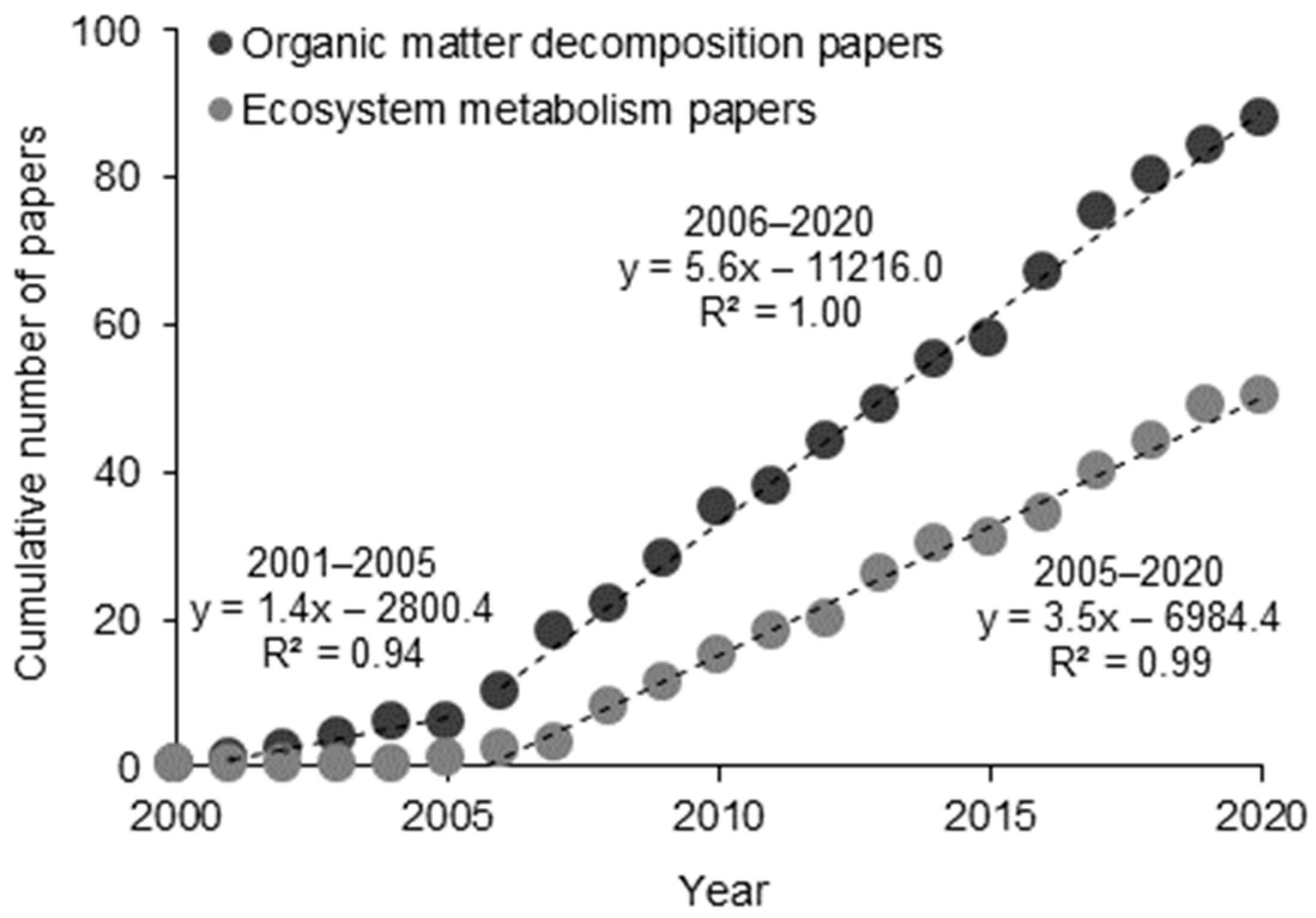
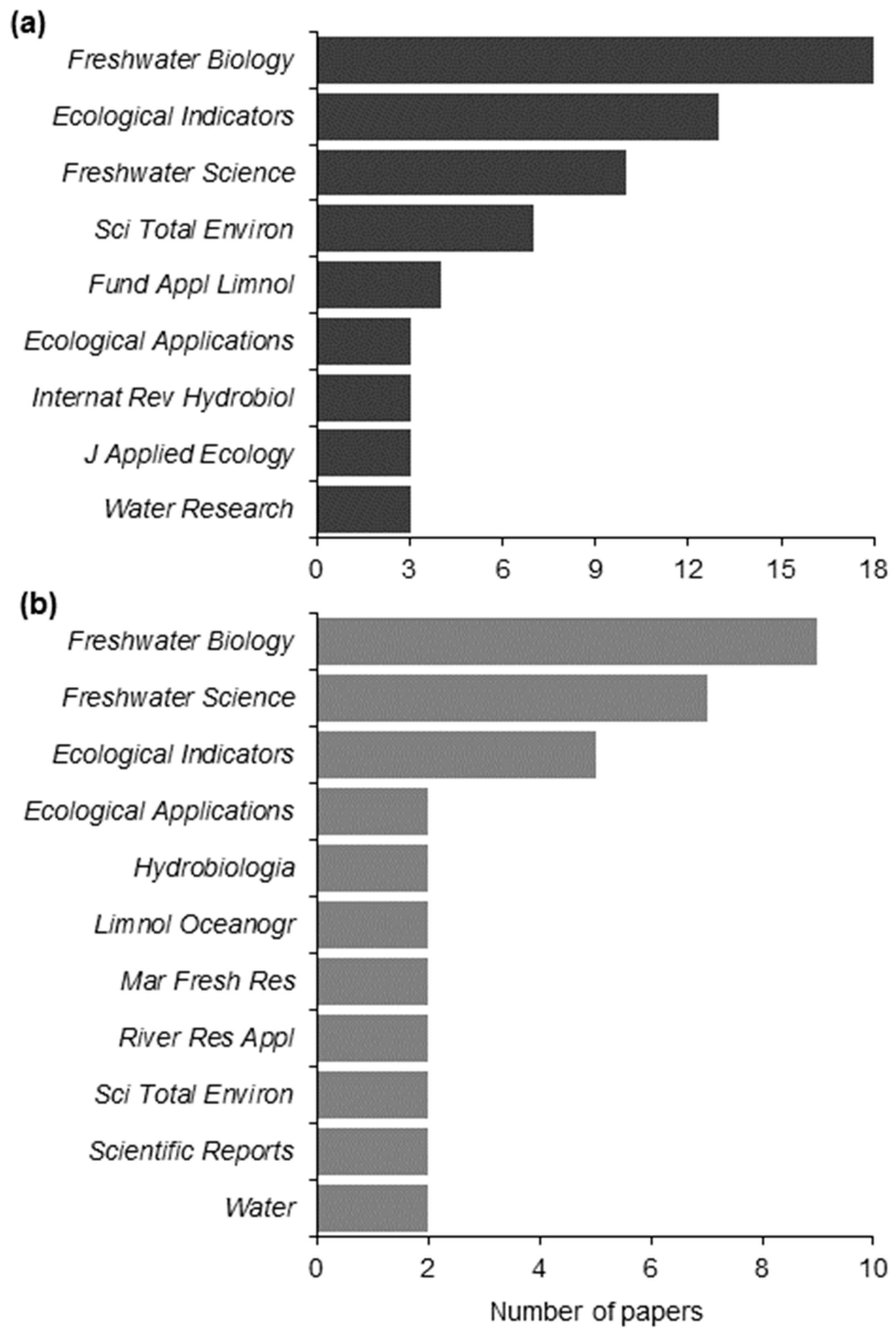
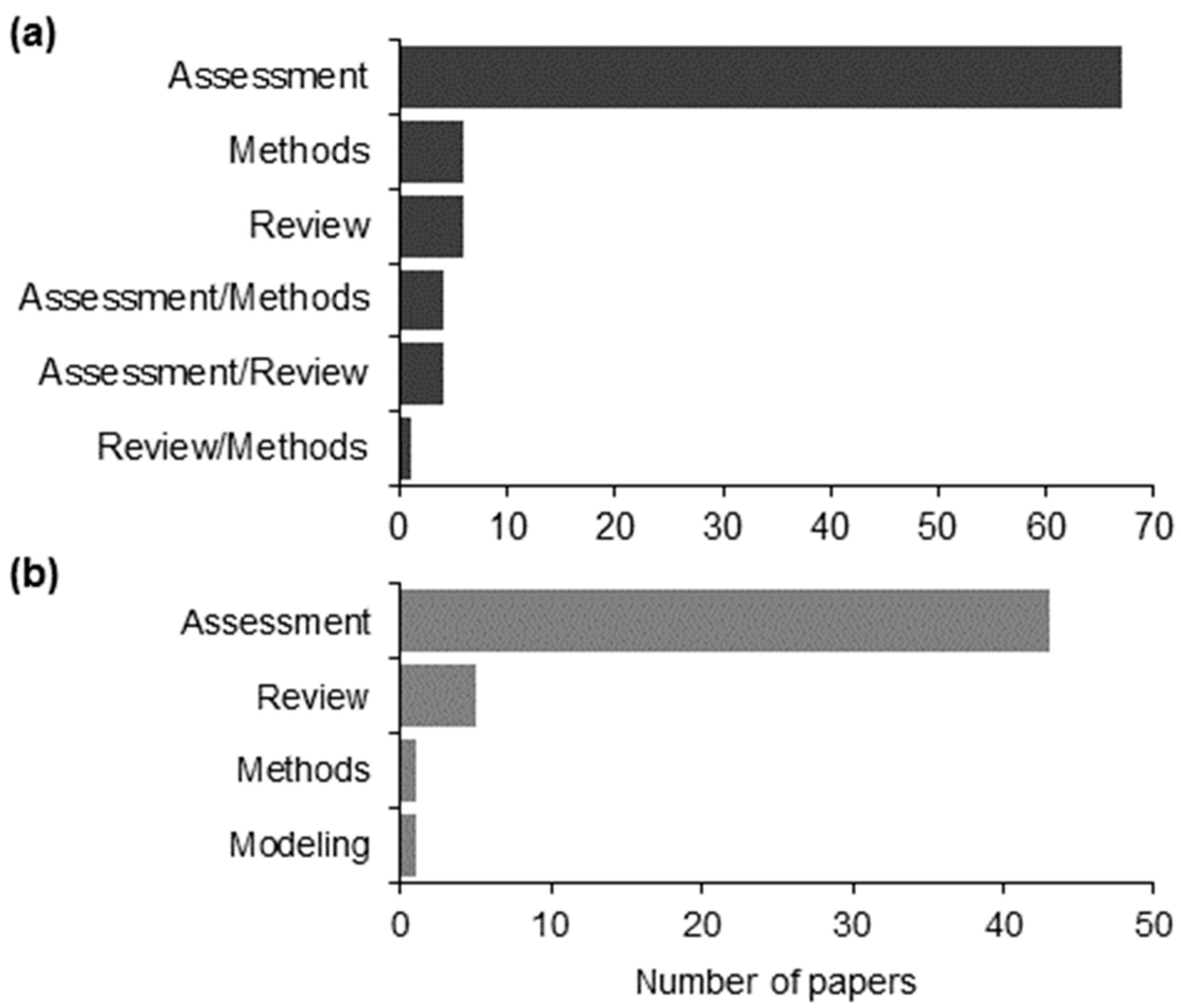
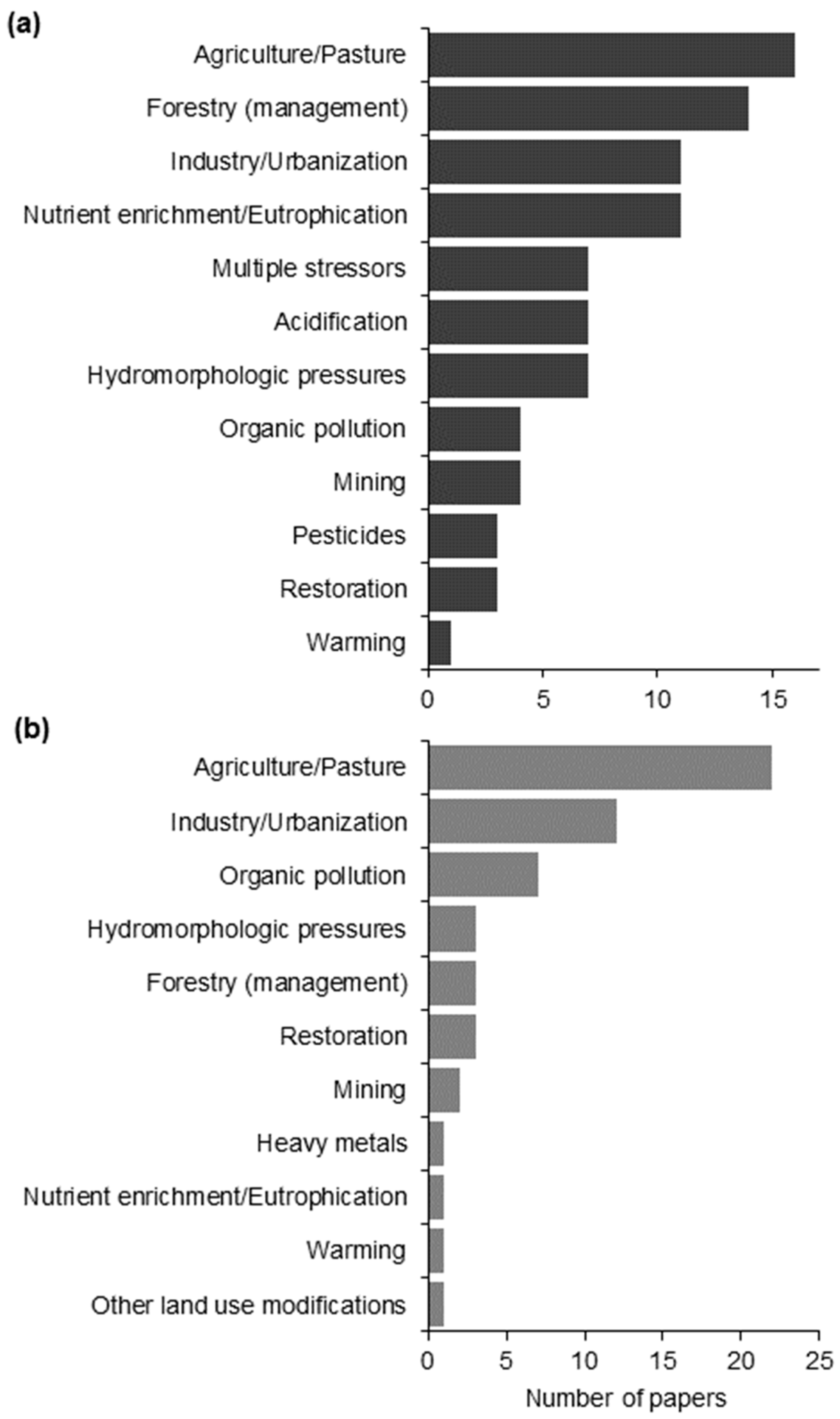
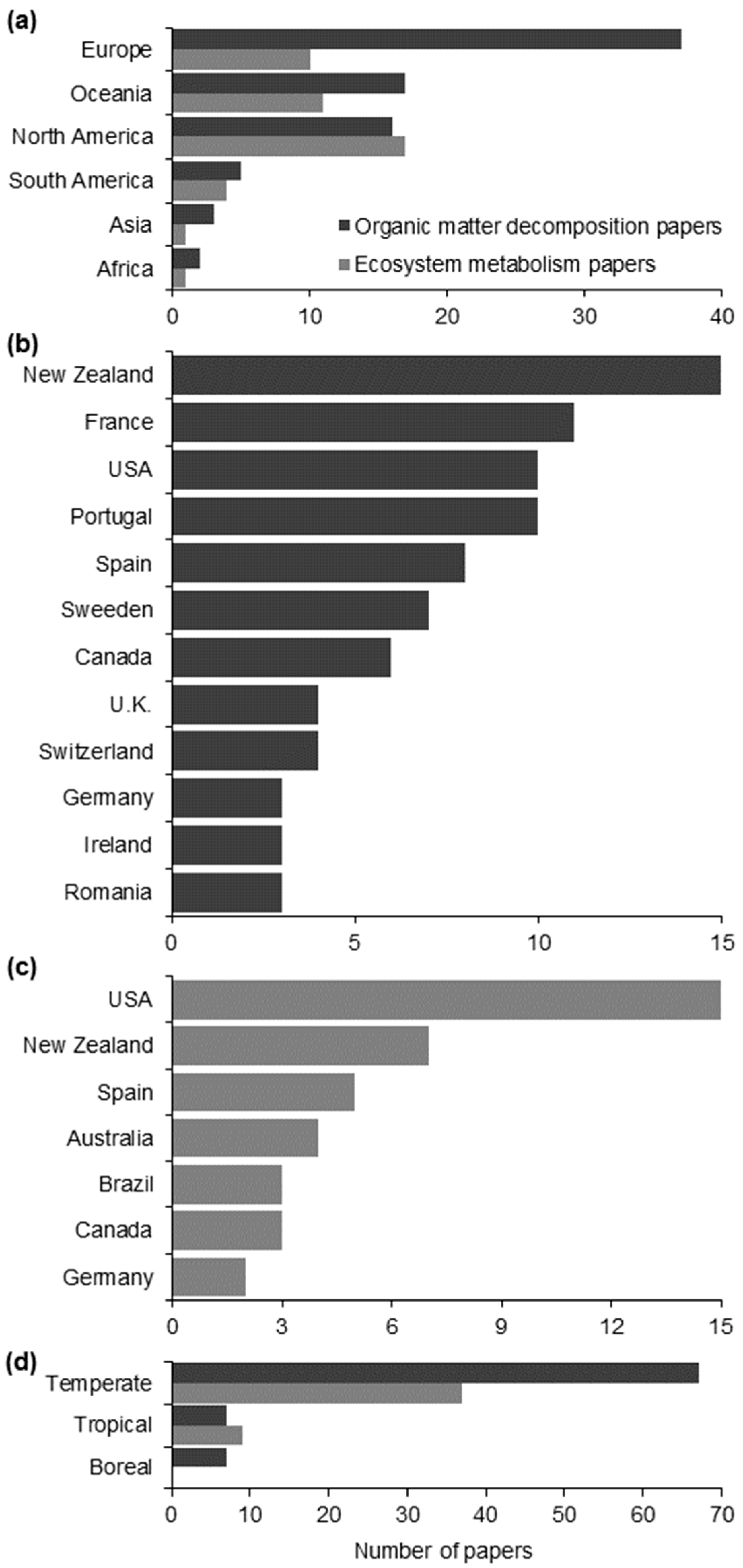
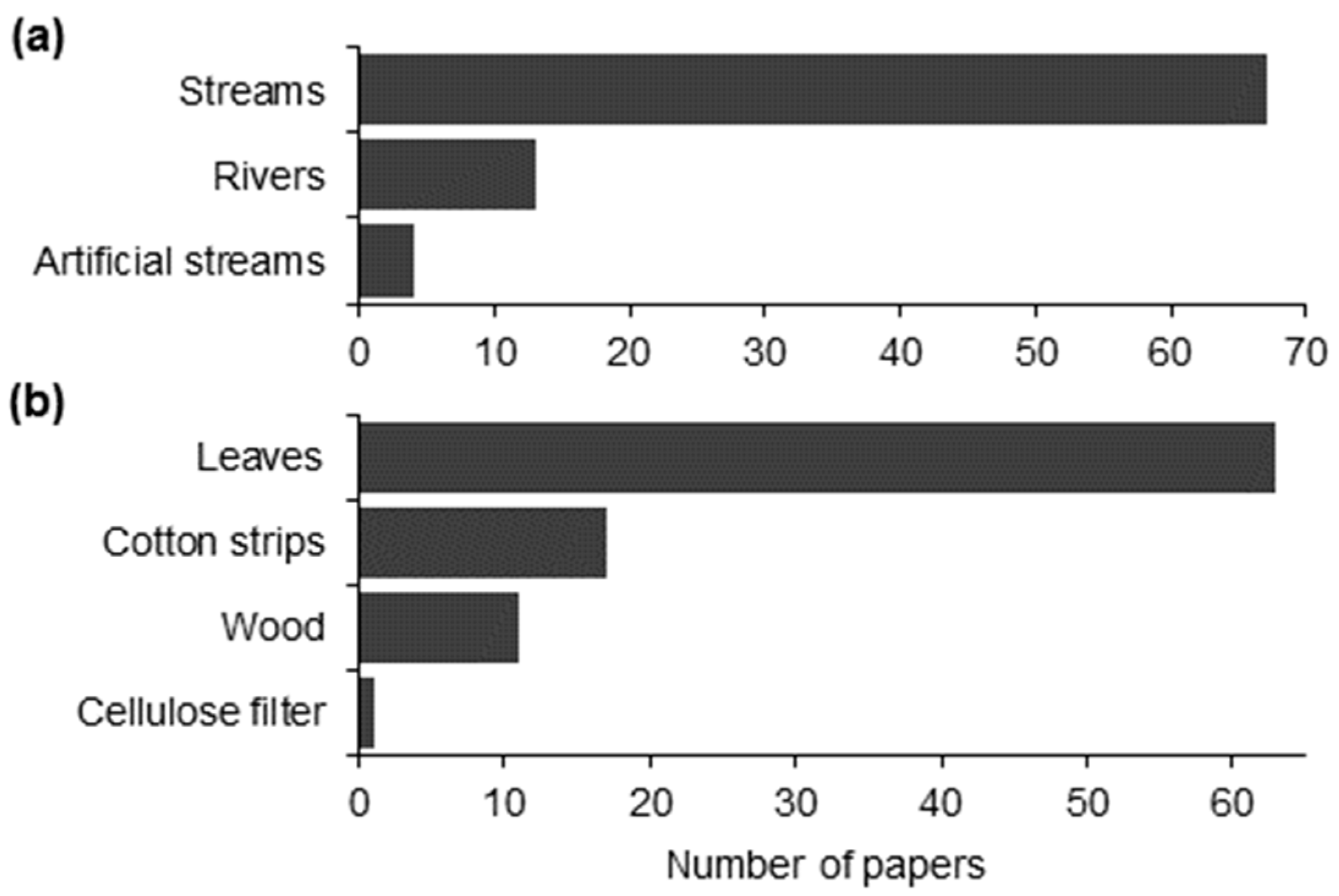
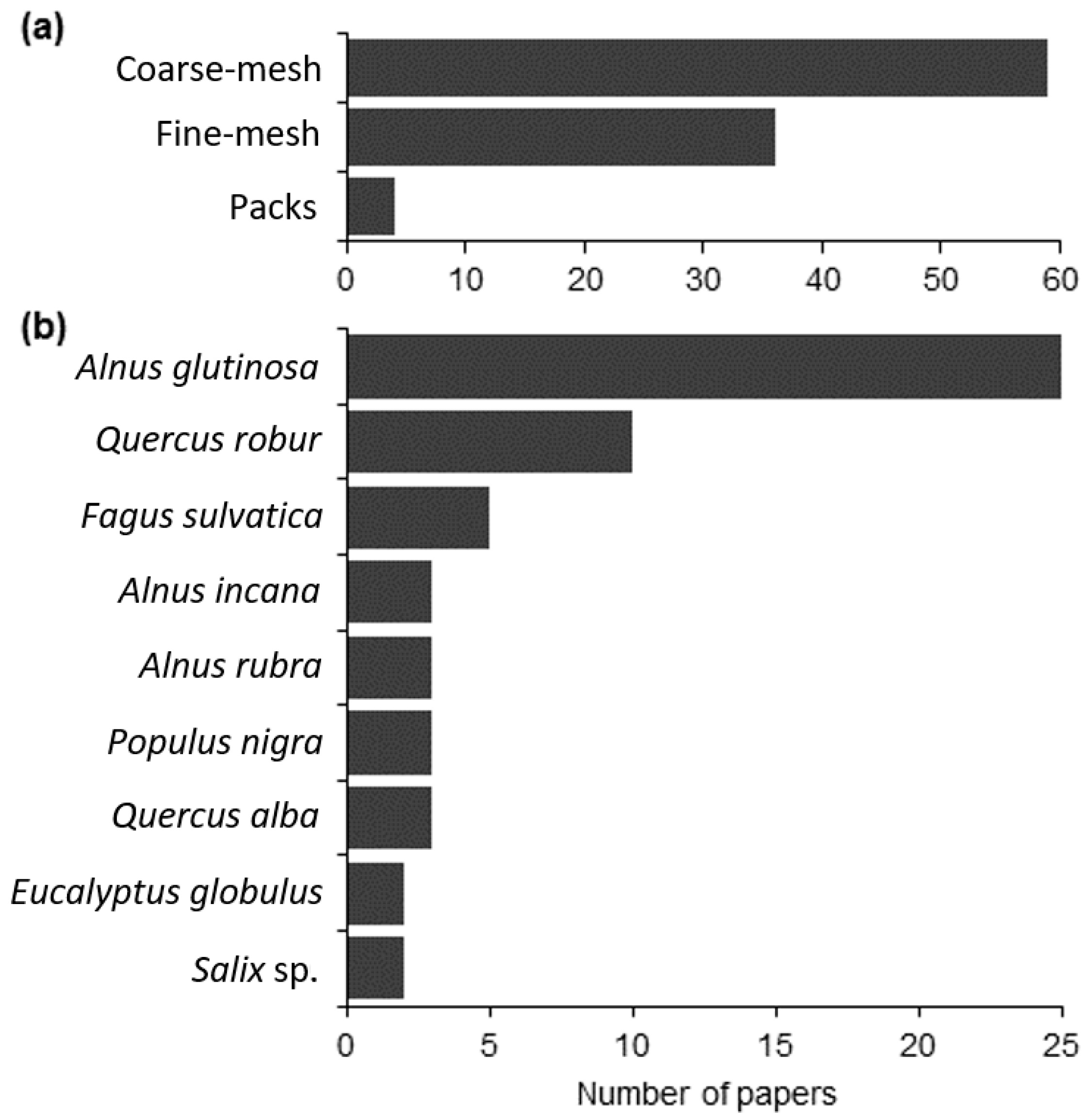
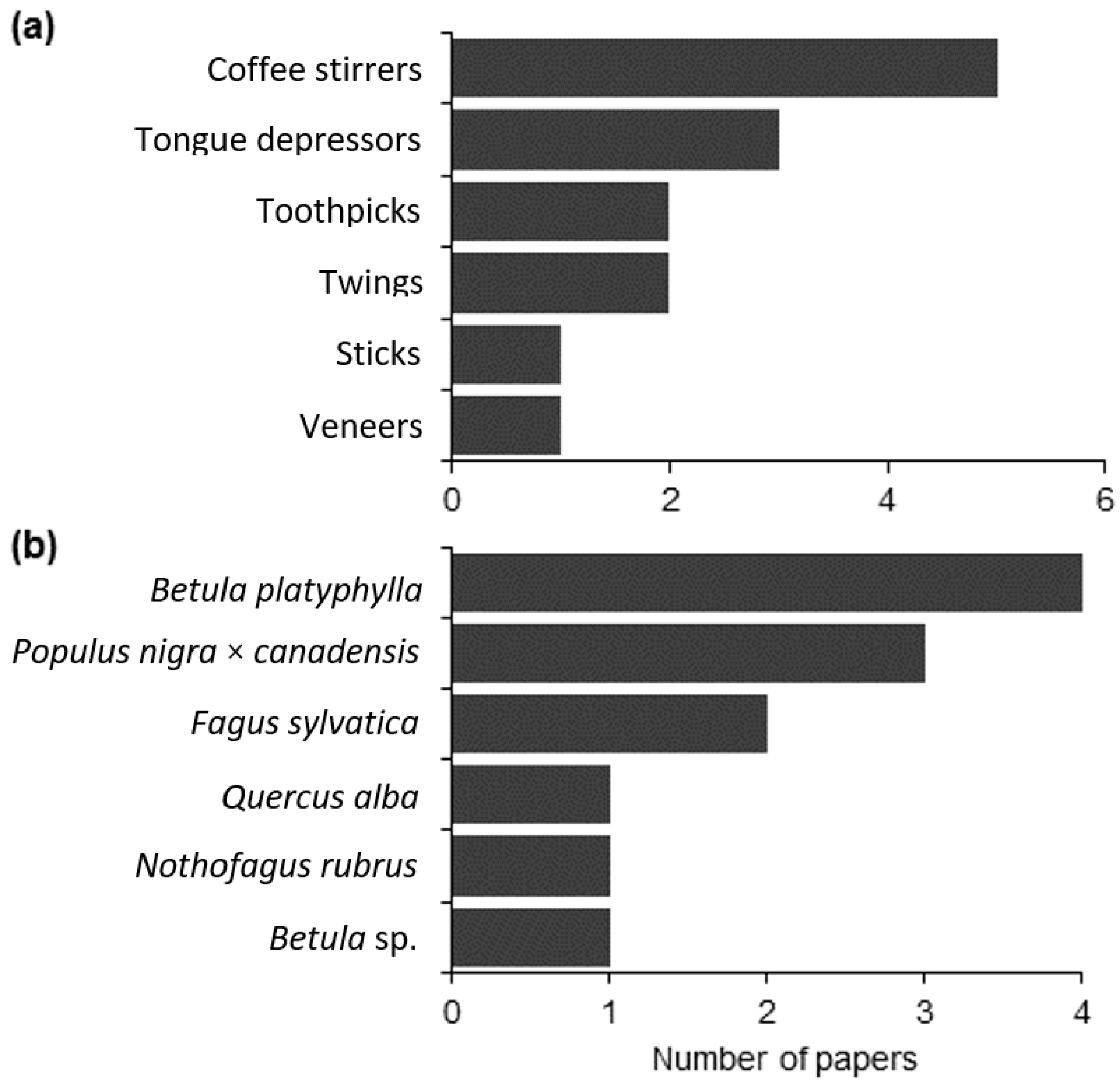
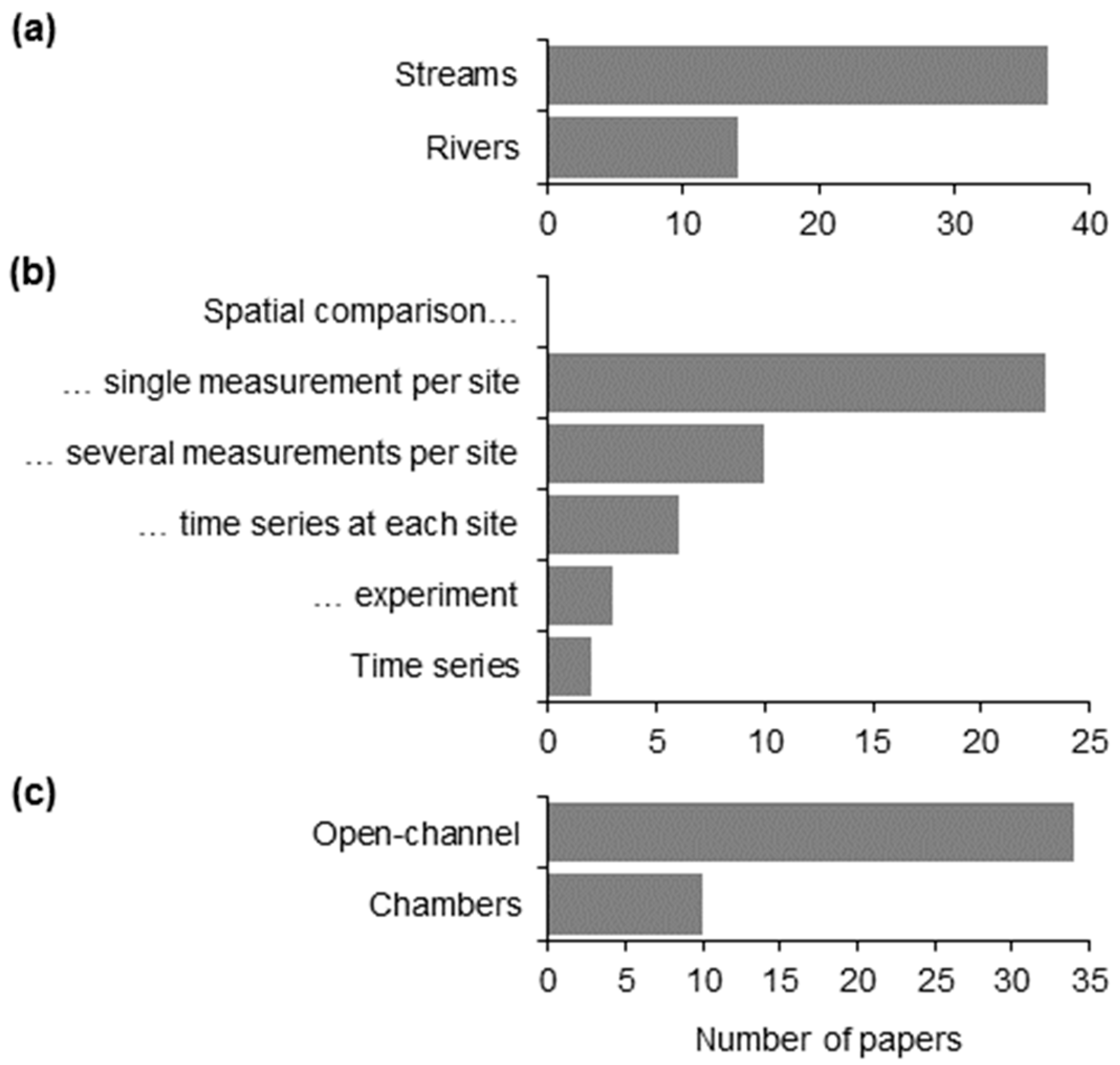
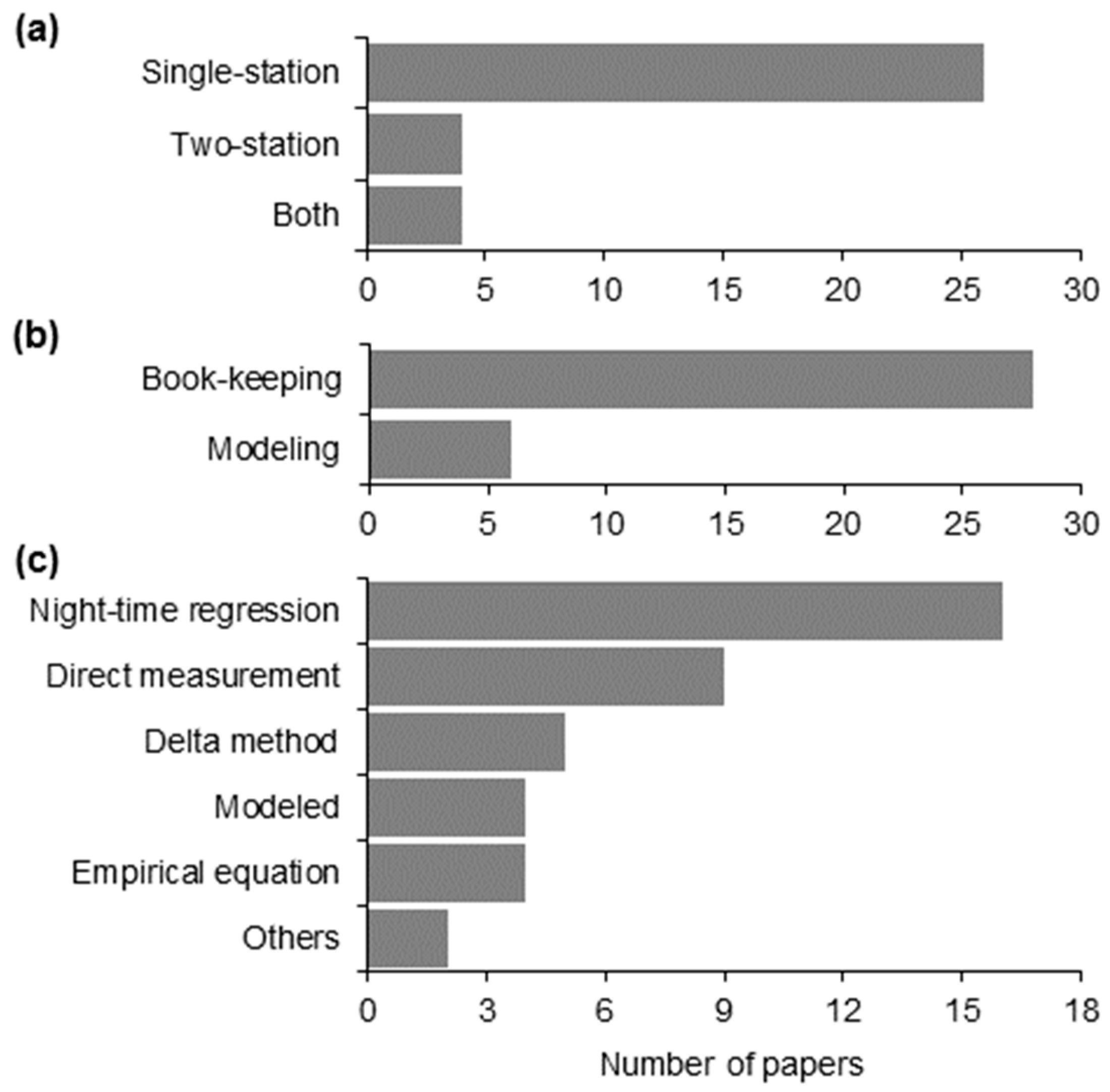
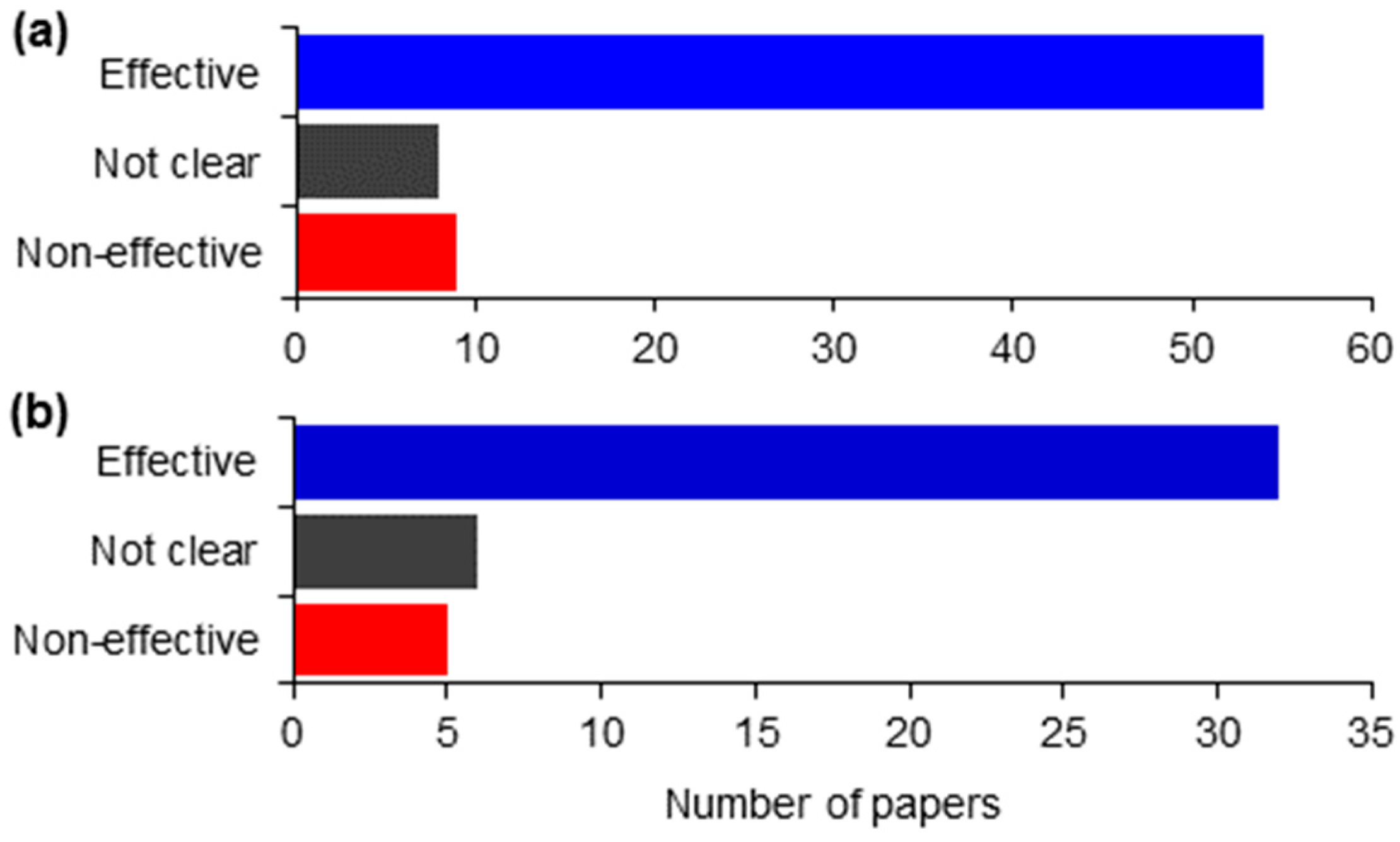
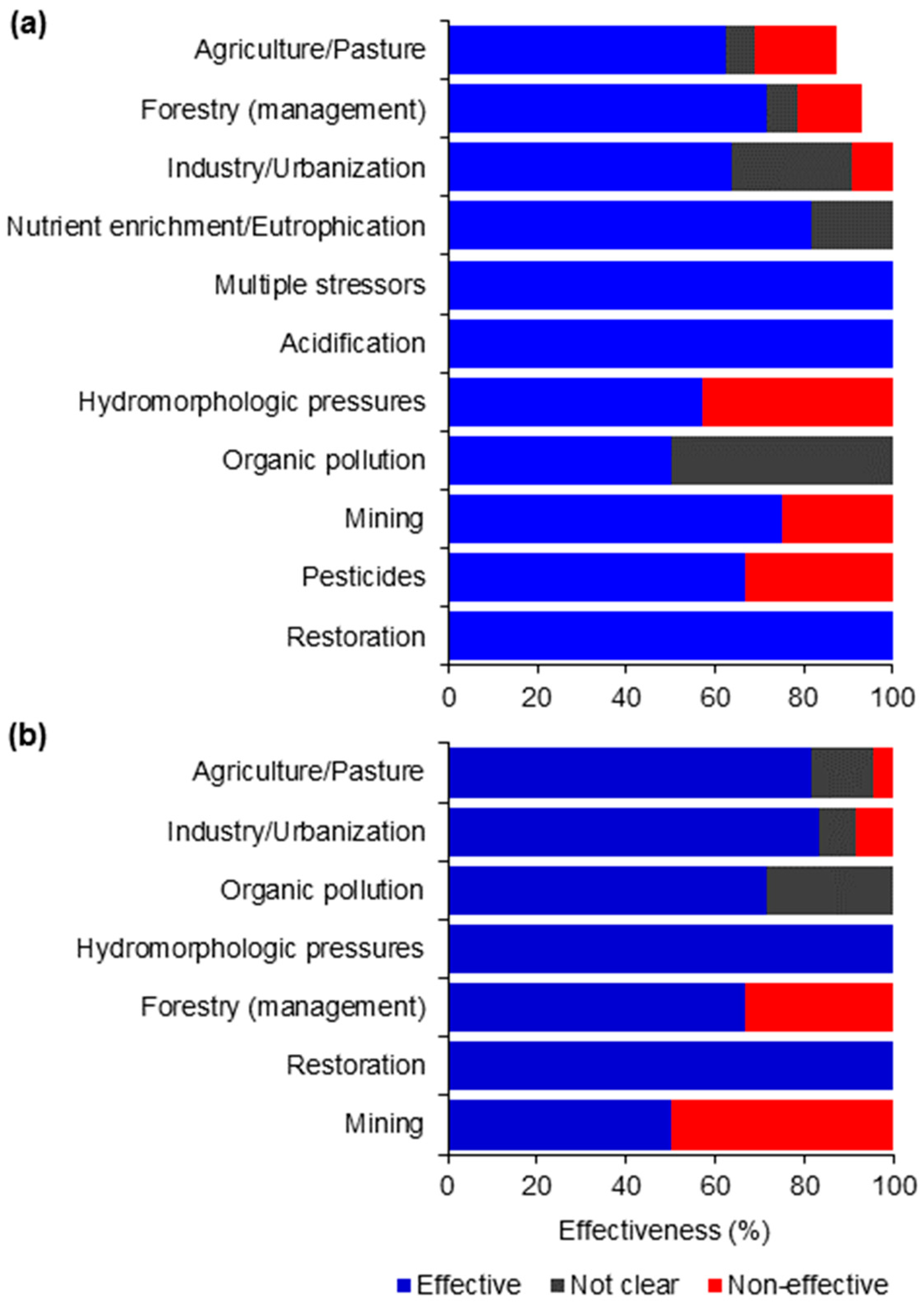
| Attributes | Leaf Litter | Wood | Cotton Strips |
|---|---|---|---|
| Derived from sound theoretical concepts in ecology | |||
| A priori predictive | |||
| Sensitivity to common stressors | |||
| Potential to discriminate anthropogenic disturbances | |||
| Linear stressor-decomposition relationship | |||
| Large-scale applicability | |||
| Incorporates the feeding activity of invertebrates | |||
| Realism of substrate | |||
| Ease of use | |||
| Cost of use | |||
| Incubation duration | |||
| Repeatability |
| Season | No. of Studies |
|---|---|
| Autumn | 13 |
| Autumn/winter | 20 |
| Autumn/winter/spring | 3 |
| Autumn/winter/spring/summer | 2 |
| Autumn, spring | 1 |
| Autumn, summer | 2 |
| Autumn/winter, spring | 2 |
| Winter | 9 |
| Winter/spring | 3 |
| Winter/spring/summer | 1 |
| Winter, summer | 1 |
| Spring | 2 |
| Spring/summer | 1 |
| Spring/summer/autumn | 1 |
| Summer | 8 |
| Summer/autumn | 5 |
| Four seasons | 2 |
| Monthly for 16 months | 1 |
| Dry season | 1 |
| Dry season, wet season | 1 |
| Wet season/dry season | 1 |
| Not reported | 1 |
Publisher’s Note: MDPI stays neutral with regard to jurisdictional claims in published maps and institutional affiliations. |
© 2020 by the authors. Licensee MDPI, Basel, Switzerland. This article is an open access article distributed under the terms and conditions of the Creative Commons Attribution (CC BY) license (http://creativecommons.org/licenses/by/4.0/).
Share and Cite
Ferreira, V.; Elosegi, A.; D. Tiegs, S.; von Schiller, D.; Young, R. Organic Matter Decomposition and Ecosystem Metabolism as Tools to Assess the Functional Integrity of Streams and Rivers–A Systematic Review. Water 2020, 12, 3523. https://doi.org/10.3390/w12123523
Ferreira V, Elosegi A, D. Tiegs S, von Schiller D, Young R. Organic Matter Decomposition and Ecosystem Metabolism as Tools to Assess the Functional Integrity of Streams and Rivers–A Systematic Review. Water. 2020; 12(12):3523. https://doi.org/10.3390/w12123523
Chicago/Turabian StyleFerreira, Verónica, Arturo Elosegi, Scott D. Tiegs, Daniel von Schiller, and Roger Young. 2020. "Organic Matter Decomposition and Ecosystem Metabolism as Tools to Assess the Functional Integrity of Streams and Rivers–A Systematic Review" Water 12, no. 12: 3523. https://doi.org/10.3390/w12123523
APA StyleFerreira, V., Elosegi, A., D. Tiegs, S., von Schiller, D., & Young, R. (2020). Organic Matter Decomposition and Ecosystem Metabolism as Tools to Assess the Functional Integrity of Streams and Rivers–A Systematic Review. Water, 12(12), 3523. https://doi.org/10.3390/w12123523







